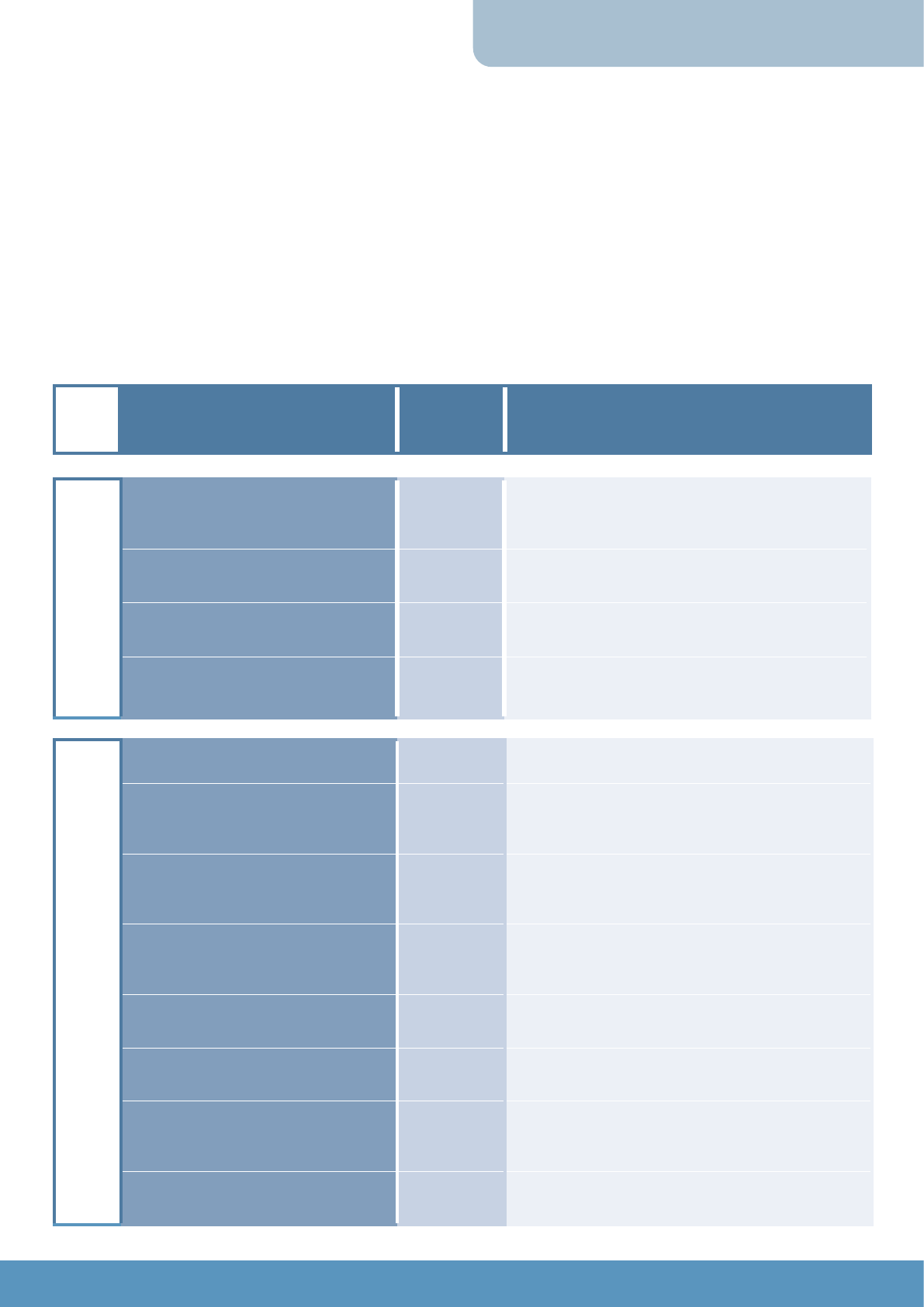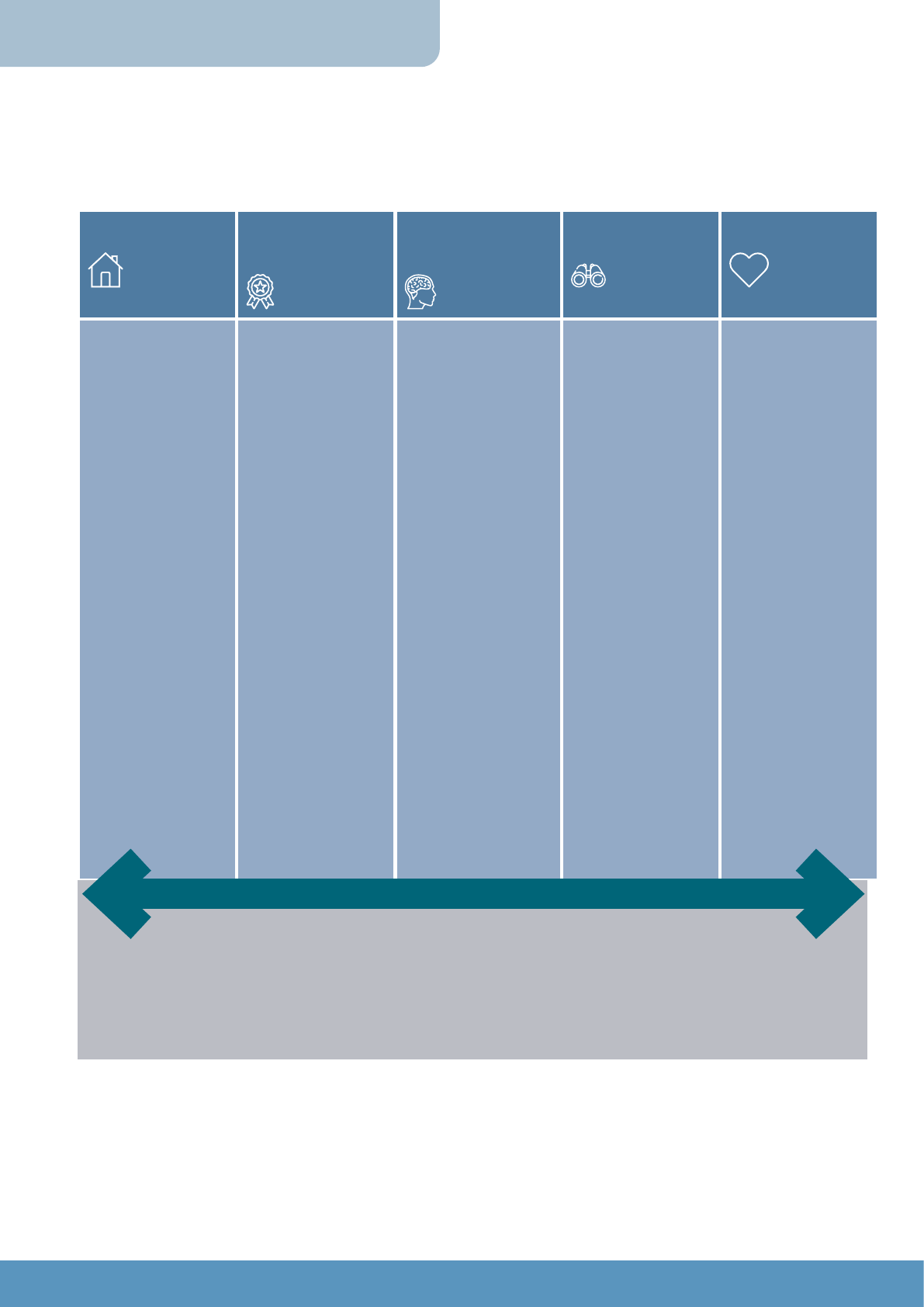
Good Assessment
Practitioners’ Handbook
Second edition
www.researchinpractice.org.uk

2
Good Assessment Practitioners’ Handbook Second edition
2
Good Assessment:
Practitioners’ Handbook
Assessment is a central part of adult social care, both as a gateway
to support and as an intervention in its own right. Good practice
in assessment is essential in order to improve the experience and
outcomes of adults and carers, to meet the expectations of law and
policy, and to enable care and support planning that uses resources in
the most effective way.
This handbook is designed to
enable you to:
> Understand adults’ and carers’
experience of assessment.
> Identify how the context of adult social
care affects your assessments.
> Understand the purpose of assessment.
> Use legal literacy to underpin your
assessment practice.
> Follow the steps that lead to
good experience and outcomes in
assessment.
> Develop the capabilities and
understanding to be a good assessor.
> Receive good support for assessment.
This handbook is aimed at practitioners who
are carrying out assessments and those who
support them, including first-line managers
and practice development staff. Practitioners
who are undertaking assessments will have
different levels of experience and professional
development, so the handbook is divided into
different sections to make it easier for people to
identify those elements that are likely to be most
useful for them.
The handbook concentrates on Care Act 2014
assessment for care and support for adults,
and support for carers. In the Care Act 2014,
assessment precedes eligibility, and care and
support planning. The handbook explores
assessment practice in its own right, whilst also
making reference to what happens following
assessment.
The handbook makes links to mental capacity
assessments and safeguarding enquiries. Adult
social care practitioners may be involved in other
assessments, for example, occupational therapists
completing assessments for major adaptations
funded by Disabled Facilities Grants under the
Housing Grants, Construction and Regeneration
Act 1996, or Approved Mental Health Professionals
completing assessments under the Mental Health
Act 1983. The same principles of assessment apply.
The information and tools in this handbook
can be used by adults and carers, and by their
advocates, to support them when they are having
assessments. They may also be useful to people
working in other agencies such as health, housing
and the community voluntary and social enterprise
sector.
Introduction

3
©Research in Practice September 2022
3
2
This edition
The first edition of this handbook came out of a
Research in Practice for Adults Change Project
called Ensuring effective assessment on the
front line, which brought research and practice
together to look at how best to ensure good
assessment in adult social care. The focus was
on supporting people to carry out assessments
that are consistently empowering and useful.
The handbook also drew on learning from a
Research in Practice Change Project in Children’s
Services called Analysis and Critical Thinking in
Assessment (Brown et al., 2014).
The handbook has been more recently reviewed
with input from Research in Practice Partners
in order to reflect the changing landscape
of assessment practice. This second edition
includes updates relating to guidance, evidence
from the implementation of the Care Act
2014, developments in practice and practice
standards. It also refers to and signposts
additional Research in Practice resources.
At the time of writing the second edition, the
major practice themes in adult social care
were equality, diversity and inclusion, and
co-production. The focus in practice was on
strengths-based work and relationship-based
practice and the importance of a human rights
approach to adult social care. The handbook
was revised after a year of practising during
the COVID-19 pandemic and so also reflects
emerging practice arising from this, particularly
relating to virtual assessment.
Language
Throughout the handbook, the aim is to use
clear and accessible language. People who are
being ‘assessed’ are referred to as ‘adults’ and
‘carers’ as this is what they are called in the Care
Act 2014, unless the handbook is referring to
evidence that uses another term. The Act talks
about ‘care and support’ for adults and ‘support’
for carers. We use ‘care and support’ throughout.
The word assessment itself is problematic.
Research in Practice Partners (2021) identified
that the word ‘assessment’ is now being
used less often and replaced by the word
‘conversation’. This is because ‘assessment’
can feel bureaucratic or like a test. However,
it is important to remember that assessment
has a meaning in law. In this handbook, we use
assessment to reflect the language of the Care
Act 2014.

4
Good Assessment Practitioners’ Handbook Second edition
4
Overview of the handbook
The handbook sets out good practice in assessment based on evidence including
research, practice experience and the lived experience of adults and carers. It
considers the quality of experience as well as the outcomes of assessment.
The handbook starts with a brief overview of the context for assessment in adult
social care, the purpose of assessment and the law that underpins it, and adults’ and
carers’ experience of assessment.
The handbook then explores three
areas:
1. Good assessment
This highlights ethics of assessment
and approaches that underpin good
assessment. The handbook sets out a series
of steps to carrying out a good assessment,
and specific elements of assessment that
need to be considered.
2. Good assessors
This looks at who should do assessments,
the capabilities that they need, and the
impact of different types of situations on
the capabilities required.
3. Good support for assessment
This looks at the support that is required
for assessors to do good assessments,
including learning and development, and
organisational support.
Overview

5
©Research in Practice September 2022
5
4
Using the handbook
Practitioners and those who support them work in busy environments. The handbook
aims to act as a reference. It can be downloaded and easily searched using the
contents page or search function. Individual pages can be printed. The tools are also
available in a form that can be edited, so that you can write onto them directly.
Throughout, there are highlighted
areas:
Main message
These are short summaries of the main
learning from the section in which they are
placed.
Reflective point
These are designed to prompt reflection on
how you can transfer the learning into your
practice.
Exercise
These support you to use the learning to
think about your own practice.
Good practice suggestion
These suggestions have emerged from the
evidence and are designed to be used to
promote discussion and reflection.
Example
These help you consider how to use the
learning in your practice.
Signposting
This signposts you to further Research in
Practice resources.
ee.gg.
Learning needs analysis
You can use the Learning needs analysis on
pages 8 to 9 to rate your current capabilities
– how you act to use your knowledge,
skills, behaviour and values in practice – for
each area of assessment practice that the
handbook covers. This will support you to get
the most out of the handbook by focusing on
the areas that you want to develop.
Following the Learning needs analysis, there
is a Learning and development plan that
you can complete as you use the handbook.
This supports you to transfer your learning
into practice, so that it impacts positively on
the experience and outcomes of adults and
carers.
Using the handbook

6
Good Assessment Practitioners’ Handbook Second edition
6
Contents
1. Learning needs analysis - page 8
2. Learning and development plan - page 10
3. Context of assessment - page 11
> Context of assessment in adult social care -
page 11
> The purpose of assessment - page 13
> Legal literacy: Assessment for Care and
Support - page 18
> Legal literacy: Links to other assessments -
page 23
> Adults’ and carers’ experiences - page 25
4. Good assessment - page 27
> Ethics and approaches to assessment -
page 28
> Person-centred approach - page 28
> Relationship-based practice - page 29
> Strengths-based practice - page 29
> Human Rights approach - page 30
> Anti-oppressive practice - page 31
> Ethics of care - page 31
> Confidentiality and consent - page 31
> Assessment steps - page 32
- Step 1: Building a relationship - page 34
- Exercise: Understanding responses to
assessment - page 37
- Step 2: Gathering information - page 39
- Exercise: Ecogram - page 41
- Step 3: Analysing the information - page
42
- Exercise: Important to, important for -
page 45
- Step 4: Making a judgement - page 46
- Exercise: Discrepancy matrix - page 49
> Action and review - page 50
> Supported self-assessment - page 52
> Joined-up assessment - page 53
> Methods of assessment - page 55
5. Good assessor - page 58
> Assessment capabilities - page 58
> Consideration of complexity - page 61
> Specific considerations: - page 63
- Carers - page 63
- Older people - page 64
- People with learning disabilities - page 65
- Autistic adults - page 65
- People with an acquired brain injury - page
65
- People with hearing and visual
impairments - page 65
- People living with dementia - page 66
- People with multiple complex needs - page
66
- People in prison - page 66
- People at end of life - page 67
- Young carers - page 67
- Young adults - page 67
> Recording assessment - page 69
> Practitioner audit - page 72
6. Good support for assessment - page 74
> Professional development - page 74
> Critical reflection - page 77
> Organisational support - page 79
Conclusion - page 83
References - page 84
Contents

7
©Research in Practice September 2022
7
6
Learning needs analysis
1. Learning needs analysis
The learning needs analysis allows you to rate your capability for each area of assessment practice that is
covered in this handbook. This feeds into a learning and development plan to help you address the areas
that you rate as low.
You can use the handbook to support your learning and development in order to meet your practice
development goals. When you have met your goals, you can revisit the needs analysis to see how your
ratings have changed.
Area Capability Capability
level (1–5)
Comments – evidence of good practice or
areas for development from feedback, practice
examples or reflection
Context
I understand the context of
assessment and how that impacts
on my assessment.
I understand the purpose of
assessment and my role in this.
I understand the legal framework for
assessment.
I know what adults and carers want
from assessment.
Good assessment
I carry out ethical assessments.
I am able to build relationships
with adults and carers to support
assessment.
I am able to gather appropriate and
proportionate information about a
situation.
I am able to analyse information
to understand the meaning of a
situation.
I am able to make defensible
judgments based on my assessment.
I support people to do self-
assessment.
I carry out joint assessments with
other agencies and organisations for
the benefit of adults and carers.
I use a range of methods of
assessment to enable involvement.
12345
12345
12345
12345
12345
12345
12345
12345
12345
12345
12345
12345

8
Good Assessment Practitioners’ Handbook Second edition
8
Area Capability Capability
level (1–5)
Comments – evidence of good practice or
areas for development from feedback, practice
examples or reflection
Good assessor
I understand the values, knowledge
and skills that underpin good
assessment.
I record assessments in ways that
empower adults and carers, and
promote their wellbeing.
Good support
I continually develop my capabilities
for assessment.
I critically reflect on the experience
and outcomes of my assessments.
I seek the appropriate support for
assessments.
I contribute to organisational
learning about assessment.
Example
Jade is a newly qualified social worker. She was asked to reflect on a recent conversation
with an older person. Jade used the learning needs analysis to consider her assessment
capabilities based on what happened in the conversation. She then discussed this with her
supervisor and wrote up the reflection and discussion for her portfolio.
ee.gg.
Learning needs analysis
12345
12345
12345
12345
12345
12345

9
©Research in Practice September 2022
9
8
Learning & development plan
2. Learning and development plan
Area of practice
(taken from learning needs
analysis)
Practice goal
(what you want to do
differently)
Actions
(to achieve goal)

11
©Research in Practice September 2022
11
10
3. Context of assessment
in adult social care
The approach we took … was to put
assessments at the centre of the legal
framework for adult social care …. It operates
both as a service in its own right, and as
the gateway to the provision of services.
Furthermore, assessment is instrumental –
along with the eligibility framework and care
planning – in determining the scope of adult
social care in practice.
(Law Commission report on Adult Social Care,
2011, p. 25).
Assessment is a central part of adult social care.
The Care Act 2014 affirmed assessment as both
the gateway to care and support as well as being
an important experience in its own right. This
reflects the significance of the decisions and
actions that assessment leads to and the impact
that assessment can have, both positive and
negative, on the lives of adults and carers.
Assessment needs to balance two central values:
> Autonomy – supporting people to make
their own decisions and to pursue their
wellbeing.
> Fairness – ensuring that resources are
distributed according to need and to
achieve outcomes.
Before the Care Act 2014 was introduced, the
Law Commission’s consultation with adults and
carers identified areas that needed to change.
These included:
> lack of clarity about what assessment is
> screening people out of assessments who
would benefit from an assessment
> not involving people fully in assessments
> concentrating on needs and problems,
rather than on abilities and aspirations
> delays in getting an assessment
> multiple assessments and duplication of
assessments
> different assessment practice leading to
different decisions on care and support
around the country
> assessments being driven by the resources
available
> assuming that carers will be willing and
able to care
> changes in care and support if people move
between services, e.g. from Children’s to
Adults’ Services
> changes in care and support if people move
house.
(Law Commission, 2011)
Context of assessment
in adult social care

12
Good Assessment Practitioners’ Handbook Second edition
12
As a result, the Care Act 2014 aimed to make
assessment practice more transparent and
consistent. The changes in the law required
assessors to work differently because of the
overarching duties: to promote wellbeing; to
reduce, prevent and delay needs; to integrate
care and support; and to provide information and
advice.
Assessment takes place within the context of a
complex and changing landscape. Since the Care
Act 2014 was enacted, England has seen ongoing
social and economic change. Implementation
of the Act has taken place against a backdrop
of austerity in public services, and the impact
of funding shortages has been exacerbated by
the COVID-19 pandemic (ADASS, 2020). The
pandemic has also highlighted disparities in risk
and health related to inequalities of income,
housing and occupation. Those inequalities may
be underpinned by issues of discrimination, in
particular due to racialisation (Public Health
England, 2020). Throughout this period there
has also been widespread technological change,
including growth in the use of social media and
digital technology.
Adults and carers have had a growing voice, and
have advocated for co-production, that is to have
equal say and involvement in designing services
and in individual assessment (for example, TLAP,
2018).
Main message
Assessment under the Care Act 2014 aims
to empower and involve adults and carers.
Reflective point
How do you talk transparently
with adults and carers about the
opportunities and constraints of
assessment?
Signposting
Nosowska and Series (2013). Good
decision-making: Practitioners’
handbook. Research in Practice
Context of assessment
in adult social care

13
©Research in Practice September 2022
13
12
The purpose of
assessment
The Research in Practice brief guide to
assessment, which is written for the general
public, explains what an assessment is.
An adult social care assessment is a
process which identifies what you want
to achieve in order to maintain or improve
your wellbeing, whilst having as much
independence and control over your day-
to-day life as possible. The things you want
to achieve that support your wellbeing
are often referred to as your ‘individual
outcomes’. … Under the Care Act 2014, your
local council has a duty to carry out an
adult social care assessment with anybody
they are aware of who seems to need care
or support. (McNamara, 2018, pp. 2–3)
The Research in Practice brief guide for
carers says:
The Care Act 2014 gives carers a legal right
to an assessment of their needs (regardless
of how much care they provide) and suitable
support to help them in their role as a
carer. This assessment of need is usually
done by the local authority, or a voluntary
organisation working on their behalf. Even
where carers are not eligible for funded
support, councils have a duty to provide
information and advice to carers. The Care
Act has improved rights for carers and
means that a carer’s eligibility for support
may have changed. … Carers are entitled to
an assessment even if the person they care
for does not receive support from the local
council. (Bishop, 2016a, p. 2)
The rights set out in the Care Act apply to
adult carers (over the age of 18) and young
carers (aged under 18) who are caring for
someone over 18. For young carers and
adults who care for disabled children,
assessment and support is also guided
by children’s law and practice. When a
professional is assessing a carer’s needs
and those of the person they care for, the
Care Act says that the circumstances
of the whole family should be taken into
consideration so that the support a family
receives is as joined up as possible. This
includes making sure the needs of any
young carers in the family are included. The
assessment will look at the carer’s physical,
emotional and mental wellbeing, and what
support might be needed to maintain it. (p.
3)
Context of assessment
in adult social care

14
Good Assessment Practitioners’ Handbook Second edition
14
Section 1 of the Care Act 2014 states, ‘The general
duty of a local authority, in exercising a function
under this Part [Care and support] in the case of
an individual, is to promote that individual’s well-
being.’ This means that assessment is ultimately
undertaken to promote wellbeing.
The Change Project Development Group
(Research in Practice for Adults, 2014) identified
the overarching purpose of assessment as
maintaining or improving quality of life. They also
identified a series of aims that underpinned this
overarching purpose:
> identifying the need behind the assessment
> managing crisis
> building a relationship
> sharing information and advice
> co-producing a picture of needs, risks and
strengths
> gathering evidence for analysis
> making a judgment, including managing risk
> identifying outcomes, priorities and goals
> ensuring appropriate level of care and support
> maintaining/improving quality of life.
Throughout this, assessors need to be able to show
transparency in their thinking and decision-making.
There is also an organisational need to gather
information about the assessment to inform service
development and improvement.
The Care Act 2014 statutory guidance (first
published in October 2014 and last updated in April
2021) states that assessment ‘should not just be
seen as a gateway to care and support, but should
be a critical intervention in its own right’ (DHSC,
2021a, para. 6.2). Ultimately, assessment should be
an empowering experience that helps someone to
understand their situation and access the support
that they need to achieve outcomes. This has an
ethical element, including the promotion of people’s
human rights. An individual assessment is not an
isolated activity, however; the assessment of one
person must always be balanced with the needs
and rights of others, including how resources will be
shared.
Assessment has a number of stakeholders and the
purpose of assessment may be different for each of
them. They will each bring different views and values
to bear on the assessment.
Context of assessment
in adult social care

15
©Research in Practice September 2022
15
14
The Change Project Development Group (Research
in Practice for Adults, 2014) identified the following
stakeholders and their considerations:
> Adult or carer – human rights, outcomes, life
experience, wellbeing, being heard, appropriate
support.
> Carer of adult being assessed – know needs will
be met, acknowledgement, information, reduce
stress, advice.
> Assessor – professional integrity for the work
that you have completed, doing the best for
people.
> Family – support, being listened to, information,
assurance that needs are being met.
> Organisation – meet legal duties, target
resources, provide outcomes, facilitate
prevention of care and support needs.
> Other professionals/agencies – information,
support for decisions.
> Providers – meeting needs in way person wants,
information for support planning.
> Commissioners – developing the market to
provide choice, identifying gaps.
> Wider community – concern about risks to
adults, carers and others.
Ultimately, assessment is a balance between what
the person being assessed needs and wants, and
what is possible – in terms of their strengths, network
and community, and the resources available. The
goal of assessment should be to support people to
understand their situation so that they can make
their own judgments about what is needed and make
decisions and take actions to achieve what’s needed.
But this may be constrained by the level of capacity a
person has to take a lead in this process; that ability
may be affected by:
> An impairment that affects their capacity,
in which case the Mental Capacity Act 2005
should be followed.
> Difficulties with being heard, in which case
advocacy should be considered.
> The effects of life circumstances, in which
case an empowering relationship may help to
overcome the barriers.
Main message
The ultimate purpose of an
assessment is to promote wellbeing.
Reflective points
> How do you explain
assessment to adults and
carers?
> How do you balance the
principles of autonomy
(supporting someone to
have choice and control) and
fairness (ensuring equality
of access to resources) in
assessment?
Good practice
suggestion
Look at a recent assessment made
by you or a colleague has done.
Identify how the assessment
empowered the person being
assessed.
Signposting
McNamara (2018). Assessment: Brief
Guide. Research in Practice
Bishop (2016a). What rights do carers
have to an assessment of their needs?
Brief guide. Research in Practice
Context of assessment
in adult social care

16
Good Assessment Practitioners’ Handbook Second edition
16
DO
> Come prepared, having read the
notes.
> Be honest, show empathy and listen
carefully.
> Be friendly and professional so I can
trust and have confidence in you.
> Explain what a carer’s assessment
is (that it’s about my needs, not an
assessment of my caring ability).
> Prioritise the person I care for and
make sure you listen to them.
> Find out about the situation on a
bad day – to understand fluctuating
needs.
> See me as an asset, part of a support
network helping to support the
person I care for.
> Be knowledgeable of services and
suggest options that might help.
> Talk about what can be done, rather
than what can’t.
> See beyond me as just a carer.
> Give me a contact number and a
name of a person I can get hold of.
> Write a summary of what has
happened so that other people can
prepare themselves before visiting.
DON’T
> Appear to be or be in a rush.
> Use jargon or buzzwords (in writing or
speaking).
> Make assumptions about what I like
or can do.
> Be afraid of saying ‘I’ll get back to you
as I don’t know the answer.’
> Make promises you can’t keep.
> ‘Signpost’ me endlessly with no result
– help me use the information that
you can give me.
The Social Work Practice with Carers’ project (www.carers.ripfa.org.uk) identified top
tips for assessors:
Top tips for assessors
Context of assessment
in adult social care

17
©Research in Practice September 2022
17
16
BASW and Shaping Our Lives developed
a charter for disabled adults and social
workers to work better together (2016).
This includes the following
commitments:
> We will start with the disabled person’s
own views of their situation, priorities,
aspirations and preferences.
> We will be honest about what is possible
and what is not.
> We will have conversations rather than
being bound by forms and procedures.
> The conversations will be meaningful and
will be about what disabled adults want.
> We will act like people and not just follow
mechanistic processes.
> We will be ambitious for each other,
thinking big and creatively.
> We will show respect for each other’s
choices, preferences and cultures.
> We will listen to and act on what is not
working.
> We will continue to work to overcome
power imbalances between disabled
adults and social workers, leading to equal
relationships and co-producing solutions.
> We will be prepared to talk about how the
context is impacting on us.
> We will talk about money.
> We will look at all options to promote
wellbeing, not just formal care services.
> We will strive to ensure that advocacy is
available for people who need it.
> We will highlight the barriers that prevent
disabled adults from living full lives,
including barriers to work.
Reflective points
> How do the top tips and the
charter reflect your practice
with carers and adults?
> What examples do you have
of good practice and where
might you want to develop
your practice?
Context of assessment
in adult social care

18
Good Assessment Practitioners’ Handbook Second edition
18
Legal literacy: Assessment for care and support
Legal literacy can be defined as ‘the ability to connect relevant legal rules with the
professional priorities and objectives of ethical practice’ (Braye & Preston-Shoot,
2016, p. 4). It is a mixture of:
Law - doing things right
Assessors need to ensure that their assessments
are lawful and know when to seek legal
guidance. There have been judicial reviews and
Ombudsman complaints about the application
of the Care Act, relating to how well the Care
Act framework, regulations and guidance have
been applied. Assessors and those who support
them can learn from these, for example through
reading case law summaries.
Rights - thinking derived from human
rights and equality
It is important not just to know the letter of
the Care Act 2014, but also to understand the
underpinning human rights law that guides the
principles by which the Care Act 2014 is used –
i.e. the Equality Act 2010 and the Human Rights
Act 1998.
Ethics - doing the right things
Ethical literacy is needed to understand the
spirit of the law, and structural literacy is needed
to understand how the law can be used either
to challenge inequality or to further it (Braye &
Preston-Shoot, 2021, p. 19).
The Care Act 2014’s aim was to simplify, clarify,
update and improve adult social care through a
single law that reflects good practice for adults
and carers. Regulations go alongside the Act
to clarify and explain it further. These include
national eligibility criteria.
Assessment is part of wider Care Act 2014 duties
(see diagram below taken from the Care and
Support Statutory Guidance, DHSC, 2021a, para.
6.12).
Context of assessment
in adult social care

19
©Research in Practice September 2022
19
18
Throughout the process:
Does the
person have
capacity?
Do they need support
for involvement,
including independent
advocacy?
What is the impact
on the whole family?
Should there be a
carer’s assessment?
Is there a
safeguarding
concern?
If, after review, the care support plan changes - or if the person’s needs or
circumstances change - then a proportionate assessment takes place.
First contact:
assessment
begins
Assessment
process
Eligibility
determination
Care and
support
planning
Review
Needs can
be met by
supporting the
person’s own
strengths,
by universal,
community
or voluntary
services, by
information
and advice, or
by a carer
After assessment, the person and anybody else must be given a record of the assessment.
The person must also receive a written record of the eligibility determination.
Context of assessment
in adult social care

20
Good Assessment Practitioners’ Handbook Second edition
20
The Care Act 2014 states that the general duty of
a local authority in everything that it does in
relation to identifying and meeting care and
support needs, including assessment, is to
promote that individual’s wellbeing (Part 1,
Section 1(1)).
Does the
person
have
Do they need
support for
involvement,
what is the impact
on the whole
family? Should
there be a carer’s
Is there a
If, after review, the care support plan changes - or if the person’s
needs or circumstances change then a proportionate assessment
First
contact:
Eligibility
Care and
support
planning
Review
Needs can
be met by
supporting
the person’s
own
strengths,
by universal,
community
or voluntary
services, by
information
and advice, or
After assessment, the person and anybody else must be given a record of the
assessment.
These are the areas that need to be considered
in an assessment. There is no hierarchy and all
should be considered for a holistic assessment.
Adults and carers must be assessed where it
appears that they may have needs (including
if those needs are future needs for a carer),
regardless of the level of needs or their financial
resources. Carers may be assessed even if they
are providing care as paid or voluntary work
(DHSC, 2021a, para. 6.17).
Assessment involves looking at an adult’s
needs for care and support, or a carer’s needs
for support, the impact of these on their areas
of wellbeing, outcomes they want to achieve,
and what will help them to achieve that (Care
Act 2014, Part 1, Sections 9 and 10). This should
include consideration of the duties of:
> Preventing, reducing or delaying needs
(Part 1, Section 2).
> Promoting integration of care and support
(Part 1, Section 3).
> Providing information and advice (Part 1,
Section 4).
The duty on the local authority (required by
s9(4)(a) and s10(5)(c) of the Care Act 2014) is
to make judgments concerning the impact of
an individual’s assessed needs on each of the
possible elements of their wellbeing, which are
set out in s1(2). The Care and Support Statutory
Guidance sets out how wellbeing is to be
applied, both for adults and carers. For carers,
this includes the sustainability of the caring role.
The assessment forms the basis of the eligibility
determination.
Wellbeing relates to:
a. personal dignity (including
treatment of the individual with
respect).
b. physical and mental health and
emotional wellbeing.
c. protection from abuse and neglect.
d. control by the individual over day-
to-day life (including over care and
support, or support, provided to the
individual and the way in which it is
provided).
e. participation in work, education,
training or recreation.
f. social and economic wellbeing.
g. domestic, family and personal
relationships.
h. suitability of living accommodation.
i. the individual’s contribution to
society. (Part 1, Section 1(2), Care
Act 2014).
Context of assessment
in adult social care

21
©Research in Practice September 2022
21
20
The Care Act 2014 emphasises the importance
of the adult or carer choosing who should be
involved (Part 1, section 9 and section 10). There
is a duty to provide independent advocacy
where this is needed (Part 1, section 67). This
could include relatives, friends, neighbours,
representatives from other agencies or anyone
who is important to that person.
A local authority may carry out a needs
assessment or carer’s assessment with another
agency (Part 1, section 12). Local authorities
may also assess young people, young carers and
carers of young people who are approaching
18 years of age (Part 1, sections 58-66). The
statutory guidance (DHSC, 2021a) emphasises
that the advocacy duty also applies to children
who are approaching the transition to adult care
and support, when a child’s needs assessment
is carried out, and when a young carer’s
assessment is undertaken.
People have the right to refuse an assessment
(Part 1, section 11). However, assessment should
still be done if the person lacks capacity, or they
are experiencing or at risk of abuse or neglect.
Following the assessment, there is an eligibility
determination (Part 1, section 13), and duties
and powers to meet needs (Part 1, sections 18–
20). The local authority has a duty to ensure that
eligible needs are met, subject to considerations
in relation to residency and immigration status,
needs that are already being met, and choice.
There are national eligibility criteria that give
the threshold for eligible needs. These are based
on meeting three conditions:
> Having needs (because of a physical or
mental impairment or illness).
> Not being able to achieve outcomes in
areas that are specified in section 3 (1) of
the Care Act 2014 (including because the
person needs assistance or it causes pain,
harm or impacts on other areas of well-
being to do so).
> There being a significant impact on their
wellbeing.
The outcomes for adults include personal care,
relationships, occupation and access to services.
The decision on eligibility is made without
reference to what the carer is willing and able
to do, though care and support planning will
include consideration of what the carer is doing.
For carers, eligibility focuses on not being able
to achieve specified outcomes and / or the
consequences or impact of providing care for an
adult, that result in a deterioration of the carer’s
‘physical or mental condition’.
The assessor therefore needs to work with the
individual to understand how needs may be
stopping them achieving outcomes and if there
is significant impact as a result.
Once eligibility has been determined, it is
necessary to identify how eligible needs could
be met. This depends on, firstly, the person’s
ordinary residence and immigration status as
these may be reasons why the local authority
may not meet needs. Secondly, there is a
determination about whether the person wants
the local authority to meet their needs, whether
any needs are already being met, and whether
any services that may be provided are ones
that the local authority charges for. The local
authority can also decide whether it wishes to
use its power to meet any non-eligible needs
(Feldon, 2017).
People whose needs are going to be met by the
local authority will then move onto the next
stage of care and support planning, including
finalising a financial assessment for any financial
contribution from the adult or carer. Care and
support planning includes setting out the
personal budget – the amount of money that the
local authority determines is required to meet
needs. People must be told during the planning
process what needs could be met by a direct
payment, and if the individual requests a direct
payment, they are entitled to receive this if the
criteria are met (Feldon, 2017).
Context of assessment
in adult social care

22
Good Assessment Practitioners’ Handbook Second edition
22
The requirements in the Care
Act 2014 are for people to be
given:
> A written record of the
determination on eligibility and the
reasons for it.
> (If not eligible) written advice and
information about—
a. What can be done to meet or
reduce the needs;
b. What can be done to prevent
or delay the development of
needs for care and support, or
the development of needs for
support, in the future.
> (If not meeting needs) written
reasons for not meeting the needs
> (If meeting needs) a care and
support plan (adult) or a support
plan (carer), and advice and
information to meet or reduce needs
that are not deemed eligible
> (If meeting needs) a Personal Budget
statement
> (If circumstances change) a revised
care and support plan (adult) or a
support plan (carer).
> The eligibility framework to
ensure that there is clarity and
consistency around local authority
determinations on eligibility.
Main message
Assessors need to be legally literate
and learn from inquiries into whether
the legal rules have not been applied
correctly, for example, through
Research in Practice’s Case Law and
Legal Summaries.
Reflective point
In practice, an assessment often does
not neatly follow legal steps. However,
it must not be led by what is available,
what someone is likely to need or how
much money they have. How do you
ensure that your assessments meet the
requirements of law?
Good practice suggestion
It is important to be familiar with
both the Care Act 2014 letter of the
law and the Statutory Guidance.
Teams or groups of practitioners can
take it in turns to present sections
so that they are reminded of what is
covered.
Signposting
Feldon (2017). The social worker’s
guide to the Care Act 2014. Critical
Publishing
Research in Practice Legal Literacy:
Change Project
Case Law and Legal Summaries for
social care practice
(researchinpractice.org.uk)
Context of assessment
in adult social care

23
©Research in Practice September 2022
23
22
During an assessment, it may be
suspected that someone is at risk of
or is experiencing abuse or neglect. A
safeguarding alert would be made and
the local authority would decide how best
to carry out the safeguarding enquiry
alongside the assessment.
Alternatively, when a safeguarding alert is
made, the enquiry may reveal that an adult
or carer requires an assessment of needs
for care and support. Again, there would
be a decision about how best to carry out
the assessment and the enquiry which are
both required.
Legal literacy: Links to other assessments
The Care Act 2014 states that the local authority must carry out an enquiry if they have
reasonable cause to suspect that an adult is at risk of or is experiencing abuse or neglect
(Part 1, section 42). A safeguarding enquiry may run in parallel to an assessment for care
and support, or for support for carers (DHSC, 2021a, para. 6.57).
The statutory guidance for the Care Act 2014
(DHSC, 2021a, para. 6.11) says that if someone is
unable to request an assessment or struggles
to express their needs, the local authority must
carry out supported decision-making, helping
the person to be as involved as possible in the
assessment, and must carry out a capacity
assessment. The requirements of the Mental
Capacity Act 2005 and access to an Independent
Mental Capacity Advocate apply for all those
who may lack capacity.
Research in Practice partners (2021) identified
the need to be explicit about how the Mental
Capacity Act 2005 principles were considered
in assessment, and to ensure any relevant
information about capacity is recorded.
The Care Act 2014 requires the local authority
to take the individual’s wishes and beliefs very
seriously. The principles in the Mental Capacity
Act 2005 must be considered.
> A person must be assumed to have
capacity unless it is established that they
lack capacity.
> A person is not to be treated as unable
to make a decision unless all practicable
steps to help them to do so have been
taken without success.
> A person is not to be treated as unable to
make a decision merely because they make
an unwise decision.
> An act done, or decision made, under this
Act for or on behalf of a person who lacks
capacity must be done, or made, in their
best interests.
> Before the act is done, or the decision is
made, regard must be had to whether
the purpose for which it is needed can be
as effectively achieved in a way that is
less restrictive of the person’s rights and
freedom of action.
The Care Act 2014 says that a local authority
may only act to promote the individual’s well-
being. The Act does not allow the authority
to make an unwise decision on the grounds
that the individual wishes them to. The Mental
Capacity Act 2005 comes into play if a person is
unable to consent to something. In that case,
the authority may only go ahead with it if it
is in the person’s best interests (Jenkinson &
Chamberlain, 2019).
Context of assessment
in adult social care

24
Good Assessment Practitioners’ Handbook Second edition
24
Main message
Assessors need to be familiar with the
safeguarding provisions in the Care Act
2014 and also with the Mental Capacity
Act 2005 principles, and know what to
do if someone may not have capacity
to make a particular decision.
Good practice suggestion
Invite a practitioner with experience of
carrying out assessments related to
the Mental Capacity Act 2005 to talk
through the law and practice related
to this.
Signposting
Guthrie (2018). Risks, rights, values and
ethics: Frontline Briefing. Research in
Practice for Adults.
Context of assessment
in adult social care

25
©Research in Practice September 2022
25
24
Adults’ and carers’ experiences of assessment
Responses to the Law Commission consultation (2011) that led to the Care Act 2014
identified that assessments needed to:
> Focus on needs and outcomes.
> Focus on abilities, aspirations and
preferences.
> Involve users, including through advocacy.
> Be appropriate, proportionate and ongoing.
> Be joined up.
> Look at the whole family.
> Be jointly produced by the person being
assessed and the assessor.
> Be transparent.
> Have clear timeframes.
Assessment plays an important part in giving
people control and helping them to identify
and achieve outcomes (Henwood, 2012), as part
of the Care Act 2014’s emphasis on promoting
wellbeing.
The Making It Real statements (TLAP,
2018) are statements developed by people
who use social care about how they want
it to work. These statements are very
relevant to assessment, particularly:
‘I have access to easy-to-understand
information about care and support which
is consistent, accurate, accessible and up
to date.’
‘I can speak to people who know
something about care and support and
can make things happen.’
‘I have access to a range of support that
helps me to live the life I want and remain
a contributing member of my community.’
‘I am in control of planning my care and
support.’
‘I can plan ahead and keep control in a
crisis.’
‘I feel safe, I can live the life I want and I
am supported to manage any risks.’
(TLAP, 2018, pp. 6-8 & p. 10).
Research on implementing the Care Act 2014
(Manthorpe, 2021) gives a mixed picture of
how successful it has been. This is due to the
context of austerity, the complexity of the
social care system, vagueness of terms such as
prevention, and the capabilities and capacity of
the workforce. Research in local authority case
study sites found associations between the
introduction of strengths-based approaches and
reductions in the use of more expensive forms of
long-term care, such as residential and nursing
care, and between community capacity building
and overall reductions in social care spending
and spending on unplanned healthcare (Tew et
al., 2019).
Too many people still receive fragmented and
inadequate assessments, face unmet needs
or experience service-led responses, or do not
have the lawful response needed to ensure their
involvement (Braye & Preston-Shoot, 2021, p. 8).
The specific evaluation on carers’ assessments
highlighted that the number undertaken has
fallen; it also found evidence of infrequent
assessments and reviews, and of shortfalls in the
availability of replacement care, which negatively
impacted on carers’ wellbeing and employment
outcomes (Fernandez et al., 2020, p. 31).
Context of assessment
in adult social care

26
Good Assessment Practitioners’ Handbook Second edition
26
In September 2016, Think Local Act Personal
(2017) surveyed around 1,100 adults and carers
about their experiences of Care Act 2014
assessment and associated activities. Again,
survey results (60% of respondents were carers)
show progress is still needed:
> Asked what one thing they would most
like to change, 10% of respondents
wanted to see more easily accessible/
good-quality information and advice;
and 21% wanted ‘better quality, more
flexibility or less complexity in arranging
support’ (TLAP, 2017, p. 3).
> Around one in three (34.6%) respondents
said the council ‘rarely’ or ‘never’ listened
to them; an additional one in three
(35.7%) said the council listened to them
‘sometimes’ (p. 9).
> More than half (54.2%) were ‘always’
or ‘frequently’ involved as much as
they wanted in arranging their care or
support; one in four (24.9%) were involved
‘sometimes’ (p. 10).
> Just over two-thirds (68%) were not
offered the support of an advocate (p. 2).
People also identified issues with lack of
assessment or follow-up with support after
assessment, obstacles to getting support,
high thresholds to qualify for support (p. 33),
frustration that carers’ entitlements through
assessment are either not clearly understood
or advertised by councils (p. 37), and having to
tell the same story to different professionals
numerous times (p. 39). Asked to identify one
thing that they would most like to change about
their care and support, the issue most often
identified by respondents (40%) was ‘to make it
more straightforward to understand options’ and
to get and change care and support (p. 32).
There are many disparities in access to
assessment related to information, knowledge,
technology, systems, language, culture,
suitability and stigma. People from particular
groups can face significant barriers, for example,
people who are homeless or autistic adults
(Nosowska, 2020, p. 10). Assessment, when it
recognises and overcomes these disparities and
barriers in access, is an opportunity to promote
equity in access to and distribution of resources.
Systems and processes are important in
enabling positive assessment practice - there is
a section exploring this further towards the end
of the resource.
Main message
Good assessment practice is based
on what people who use social care
say about how they want it to work.
Reflective point
How do you ensure that assessment
is transparent and makes sense to
people?
Good practice suggestion
In a team meeting or practice
forum look at the Making it Real
statements, and consider how far
your practice reflects them and what
else you could do.
Context of assessment
in adult social care

27
©Research in Practice September 2022
27
26
4. Good assessment: Principles of assessment
The Care Act 2014 sets out some principles that underpin work with individuals:
> Beginning with the person’s views,
wishes, feelings and beliefs.
> Thinking about prevention.
> Not making assumptions.
> Ensuring participation.
> Balancing adult and carer needs.
> Protection from abuse and neglect.
> Minimising restrictions.
(Part 1, Section 1 (3))
Involvement: The assessment should start
with the individual’s point of view. Ultimately, it
should be a jointly produced understanding of
the person’s situation. This reflects the exchange
model of social care, where the assessor and adult
or carer exchange expertise about the situation,
rather than the assessor acting as expert (Smale
et al., 1993). The Care Act 2014 emphasises
appropriate and proportionate assessment: this
means that assessment can be done differently
(in terms of depth, timescales and approach) for
different people as long as it achieves its purpose.
But even in a light-touch assessment, assessors
need to keep an open mind about what else
might be going on.
Prevention: The assessment should always
involve asking the question: what can be done
to prevent, reduce or delay needs? Acting
preventatively may involve providing information
and advice, signposting to other services
(e.g. low-level or reablement services), or joint
work with other agencies. It should involve
consideration of the person’s own strengths and
their informal network, as well as the community’s
capacity to support people.
Person-centred: The assessment should
be tailored to the individual and not involve
assumptions. The Equality Act 2010 specifies that
any public sector service must consider how to
‘advance equality of opportunity’ to people with
protected characteristics of: age, race, disability,
gender re-assignment, religion or belief, sex,
sexual orientation, pregnancy and maternity,
marriage and civil partnership.
Participation: If the person has difficulty in
giving their point of view, then an advocate should
be considered. This could be an informal advocate
if there is someone willing and appropriate. Or
an advocate may need to be provided. If there is
doubt about capacity, after all reasonable efforts
have been made to support the adult in making
a specific decision, then a mental capacity
assessment must be done.
Balance: The whole family should be involved
and particular consideration given to young
people. It is important that both the adult and
the carer have the opportunity and space to
state their needs. This may require separate
assessments or separate assessors. If needs
conflict, then the assessor may need to act as a
negotiator; again it may be necessary to have two
assessors or to use advocates (Webber & Wright,
2014).
Protection: Assessors need to recognise early
signs of or indicators of possible abuse or neglect.
The discussion about wellbeing should include
how people balance what is important to them
(e.g. relationships) and what is important for
them (e.g. safety). The need for a safeguarding
enquiry may be identified in an assessment.
Any safeguarding activity should start from the
outcomes that someone wants to achieve in their
life.
Reflective point
How far does your assessment practice
reflect the principles above?
Good assessment

28
Good Assessment Practitioners’ Handbook Second edition
28
Good assessment: Ethics and approaches to
assessment
Assessment is an ethical activity because it involves making judgments about
someone else, and because it has an impact on their life both now and in the
future. There is a close link between social care ethics (see, for example, the British
Association of Social Work’s Code of ethics for social work – BASW, 2021, or the Royal
College of Occupational Therapists Professional standards for occupational therapy
practice, conduct and ethics - RCOT, 2021) and the duty to promote wellbeing that
underpins assessment.
As the Care Act 2014 was embedded, many
local authorities took the opportunity to
change the relationship between the council
and communities. This included aiming to: help
people understand services; build partnerships
with communities; co-produce services; and
re-design conversations to make sure that they
clarify the person’s story and what matters to
them and are asset-focused discussions that
aim to resolve issues (TLAP, 2019, p. 11).
Person-centred approach
An assessor’s view about someone else’s life
cannot be an exact reflection of what it is
really like for them: rather, it is a constructed
account of who they are and what is happening
for them. This raises the question of whether
our record says more about our perspective
than it does about the adult or carer. It also
requires us to question how the idea of someone
is constructed – for example, what makes
someone ‘at risk’ and how does this affect how
they are perceived? (Guthrie, 2018, p. 3).
It is essential that the assessment we do is
jointly produced with the person that it is about
so that they recognise their own self in it. Also so
that we do not impose our values and views on
them.
Working in a person-centred
way is based on the following
values:
> People have the right to choose
how to live their life and are able to
do this with adequate support.
> Power should be shared so that
solutions are jointly produced.
> People are experts in their own lives.
> Planning should start with the
positive aspects of someone’s
life – the things they can do, their
passions and interests.
> People have assets, strengths and
capacities that they can bring to
bear on their situation.
> Communities can be built which
are inclusive and recognise the
contribution of all people.
> Everyone can build meaningful
connections.
(Sanderson & Lewis, 2012)
Context of assessment
in adult social care

29
©Research in Practice September 2022
29
28
Good assessment
Relationship-based practice
Relational work counters the tendency to be
procedural and for the assessment conversation
to be led by the assessor. In a relational
assessment, the conversation is reciprocal and
is built around getting to know the person and
what is important to them. There are some core
characteristics of this approach:
> Each inter-personal encounter is unique.
> Human behaviour is complex and multi-
faceted.
> The internal and external worlds of
individuals are inseparable, and so the
relationship needs to take into account
both the individual and their context.
> Relationship is the means through
which interventions are channelled.
(Ruch et al., 2018)
Strengths-based practice
A strengths-based approach involves
collaboratively exploring the person’s
circumstances and experiences with a focus on
their abilities and on the enablers and barriers
to them thriving. Research in Practice partners
(2021) point out that there has been a shift in
assessment practice from talking about deficits
to identifying what people can do. This is not
about ignoring needs but about putting them
in context and balancing them with strengths.
It is important to tell the person’s story and to
be able to identify them as an individual. This
reflects the statutory guidance, which highlights
the importance of encouraging people to use
their gifts and strengths (DHSC, 2021a, para.
6.63).
The strengths-based approach to
assessment is about having a dialogue to
identify the person’s own strengths, wishes
and priorities at various levels, the strengths
of the person’s supporting network such as
their family or friends and neighbours, and
their wider network of support, for example
local groups, voluntary organisations or local,
outlets (see diagram below DHSC, 2019, p.
45).
What have you previously enjoyed doing?
What level of independence did you once have?
What level of independence would you like to have?
What can you manage to do now?
What would like to be able to manage?
Who can support you?
Let’s plan how
you can achieve
what you wish
to and live a
fulfilling life.
Exploring these themes during the assessment conversations should help to
identify realistic expectations and the person’s desired outcomes
> The assessment is not the
document or the form.
> The assessment is a holistic
intervention.
> ‘The process of gathering
information’ can consist
of various visits, several
conversations, reading
documents, etc.
Signposting
Research in Practice (2020).
Strengths-based practice (film)
Guthrie and Blood (2019). Embedding
strengths-based practice: Frontline
Briefing. Research in Practice.

30
Good Assessment Practitioners’ Handbook Second edition
30
Human rights approach
Assessment is an activity where professional
judgment is applied in the situations of people
whose independence and autonomy might be at
risk. Therefore, its aims must align with human
rights values (BIHR, 2016).
The essential elements of the assessment
duty set out in the Care Act 2014 and
their relation to Articles of the Universal
Declaration of Human Rights
1
are:
> Adults and carers must be assessed
where it appears that they may have
needs, regardless of the level of needs
or their financial resources (Part 1,
section 9(1-3)). This relates to Article
14 – freedom from discrimination.
> Assessment involves looking at the
adult’s or carer’s needs, the impact
of these on areas on wellbeing,
outcomes they want to achieve and
what will help them to achieve that
(Part 1, section 9(4)). This relates
particularly to Articles 2, 5, and 8 –
right to life, freedom from degrading
treatment, and respect for private and
family life.
> The adult and carer must be involved,
along with any person whom the
adult asks the authority to involve or,
where the adult lacks capacity, any
person who appears to the authority
to be interested in the adult’s welfare
(Part 1, section 9(5)). This principle of
involvement echoes Article I – that ‘All
human beings are born free and equal
in dignity and rights’.
1 www.un.org/en/about-us/universal-declaration-of-hu-
man-rights
A human rights approach to assessment
includes actions to: get to know the person, their
preferences and choices; understand how the
person is able to exercise their rights; identify
barriers and enablers to the person’s dignity and
rights being upheld; and make judgments about
how best to empower the person to live a life of
dignity and equality (Nosowska, 2020, p. 11).
Signposting
Nosowska (2020). Embedding human
rights in assessment for care and support:
Frontline briefing. Research in Practice
Good assessment

31
©Research in Practice September 2022
31
30
Good assessment
Anti-oppressive practice
This approach calls for practitioners to be aware
of the impact of oppression on individuals and
of its presence in their lives. Assessors can add
to people’s experience of oppression – either
deliberately or unconsciously – by reinforcing
stereotypes, making assumptions or accepting the
structural problems that people face as inevitable.
An anti-oppressive assessment takes into account
the personal, cultural and structural barriers
that someone faces, including the potential
for the assessment to reinforce or reflect these
(Thompson, 2016). This can be explored through
using an intersectional lens, which is discussed
later in the section on building a relationship (see
page 32).
Ethics of care
Ethics of care is a theory of moral behaviour.
It is about how we respond to each person
with empathy and compassion. There are
four main elements that make up an ethical
response (Tronto, 2005):
> Attentiveness:
recognition of the other person’s needs
> Responsibility:
taking it upon ourselves to care
> Competence:
having the capability to act
> Responsiveness:
understanding how the other person is
receiving the care.
These elements link to the standards of
conduct, performance and ethics for registered
professionals. These emphasise the importance
of acting in the best interests of people and of
being ready and capable to do so.
Confidentiality and consent
Assessment requires the same ethical standards
as any form of enquiry into someone’s life – it
should be done with consent, and the information
gathered should remain confidential apart from
where information sharing is agreed. People should
be able to withdraw their consent to take part
or for information to be used. Advocacy may be
required, and the Mental Capacity Act 2005 should
be followed.
The data protection principles in the Data
Protection Act 2018 are helpful. Personal data
should be:
> Used lawfully for a specific purpose.
> Adequate, relevant and not excessive.
> Accurate and up to date.
> Shared for a purpose and with consent except
in certain exceptional circumstances
> Kept safely and only for as long as needed.
This applies to all methods of assessment, so in a
virtual environment it is important to check privacy
and security of the conversation.
Main message
Assessment has an impact on people’s
lives and is, therefore, an ethical activity.
Good practice suggestion
In a team meeting or practice forum,
read through an assessment and
discuss how this would impact on
the person who was being assessed.
What ethical dilemmas are there in the
situation? Which values underpinned
the way in which the person was
assessed?

32
Good Assessment Practitioners’ Handbook Second edition
32
Good assessment: Assessment steps
It is helpful to think of assessment as a series of steps, each of which is important in its own right and
which together lead to the final purpose of promoting wellbeing.
The steps for assessment are:
1. Building a relationship
2. Gathering information
3. Analysing the information
4. Making a judgment.
Main message
Assessment can be considered as a
series of steps with the ultimate goal
of promoting wellbeing.
Good practice suggestion
Look at an assessment record and
see if you can identify the steps of
building a relationship, gathering
information, analysing the information
and making a judgment. How was this
done?
Through building a relationship and gathering
information, we are able to determine what the
story is. Analysis enables us to understand what
the story means. We then make a judgment
which informs our eligibility determination and
any care and support planning that is required.
Research in Practice identified five Anchor
Principles for carrying out good analytical
assessments and interventions in Children’s
Services. These are questions that help
practitioners to work through an assessment,
intervention and review in a clear way. The
questions are:
> What is the assessment for?
- referral
> What’s the story?
– assessment
> What does the story mean?
– assessment
> What needs to happen?
– care and support planning
> How will we know we are making progress?
– review.
(Brown et al., 2014)
Good assessment

33
©Research in Practice September 2022
33
32
Good assessment
Miss Higgins lives alone in a bungalow in a small village on the outskirts of Maytown. She moved there
ten years ago when she retired. Miss Higgins has no close family. She had local friends in Maytown but
has lost touch with them in the last few years. However, she has friends that she phones regularly in
other parts of the country.
Miss Higgins’s closest friend in Maytown, Ann McDonald, died two years ago after a series of strokes.
For a few years before that, Miss McDonald had mostly been unable to go out, and Miss Higgins had
been looking after her, visiting her every day. Molly and Ann had been friends for 30 years and used to
travel together frequently.
Miss Higgins was a piano teacher and still has a piano at home, though she rarely plays now because
she has arthritis. She taught many of the children in the local area over the 40 years before her
retirement. She loves listening to music and used to attend a lot of concerts. Miss Higgins is also
interested in films and film scores.
Miss Higgins was admitted to hospital two months ago with breathing difficulties. She had severe
pneumonia and was in intensive care. When she came into hospital, Miss Higgins had clearly not
eaten for some time and was very dehydrated. She also had pressure sores. Miss Higgins has gradually
recovered and had rehabilitation to be able to walk with a Zimmer frame. Miss Higgins still becomes
tired very quickly and has difficulties gripping objects. She also gets a lot of pain in her legs from the
arthritis and from pressure sores that restrict how well she can move around.
During her time in hospital, Miss Higgins has been refusing all visits to her home and any discussions
about support, including referral to the hospital discharge team. It gradually became clear that
nobody has been to her home for the last four years, or perhaps longer.
Miss Higgins says that she just wants to go home and be left alone.
Miss Higgins has no close family, having moved to the area from North Wales many years ago.
One of the nurses on the ward, who was taught by Miss Higgins, believes that she and Miss McDonald
were in a relationship.
Miss Higgins is also interested in films and film scores, and in songs in her first language, Welsh.
Case study: Molly Higgins
This case study will be referred to as we look at the steps to carrying out a good assessment.
It is based on a real assessment provided by the original Change Project Development Group
and updated for the second edition. It is based on a real situation provided by the original
Change Project Development Group, though not a real person, and was updated for the
second edition.
Reflective point
Before starting an assessment, it is useful to reflect on the purpose of the assessment. This
helps to start the process of building a relationship and gathering information by identifying
some of the relevant issues to focus on. In this case, what do you think the assessment is for?

34
Good Assessment Practitioners’ Handbook Second edition
34
Step 1: Building a relationship
Assessment is a human encounter. A good
relationship is needed to enable positive
outcomes and experience (Ruch et al., 2018). The
experience of relational work may be therapeutic
– for example, it may reduce the person’s
experience of loneliness (DHSC, 2020).
Building a relationship involves using yourself to
gain trust, to establish rapport and to open up
communication. Use of self includes awareness
of how our beliefs, values, experiences and views
impact on our understanding (reflection) and of
how they affect the situation itself (reflexivity). It
involves acknowledging the emotion that is part
of the assessment contact both for the assessor
and for the person being assessed. It demands
honesty about the impact of assessment.
Taking a relationship-based approach to
assessment allows the assessor to avoid an
understanding of the person’s situation that is
based on probability or procedure (Ruch, 2012).
It is helpful to use information about what is
likely to happen and to use procedures to help
us follow steps that usually work, but this can
lead to an oversimplified view of what is going
on or to a routine response. But if we have a
relationship with the individual, then we are able
to:
> Recognise them as a unique individual.
> See what is unique to their situation.
> Identify the gaps between what we
know from research and from previous
experience, and what is happening here.
The level of relationship that is needed will be
proportionate and appropriate to the situation.
Adults and carers value both the relationship
and practical action (Beresford et al., 2008). If
someone is clear about what they need and their
focus is on getting this, then they may prefer
to focus on practical action rather than the
relationship. In other situations, the person may
have great need for empathy and understanding
before they can start to work out what is
happening and what it means.
Research in Practice Partners (2021) pointed
out that the first encounter can be a powerful
opportunity for intervention and so it is
important to give time to the person. The
practitioner acts as a listener not a judge,and
trust is built through the person experiencing
attention without judgment. This approach
helps to understand risks and strengths through
the person’s eyes and enables them to feel more
in control of their identity (Felton & Stickley,
2018). The amount of time needed to build the
necessary level of relationship will depend on the
individual and their situation, and the skills of the
assessor. It may be possible to build sufficient
relationship through a phone call, or it may be
necessary to have extensive face-to-face time
with someone.
It may be that someone else, for example, a
health practitioner, care worker or voluntary
organisation, already has an established
relationship with the person and can help you to
build your relationship. User-led organisations
and advocates can also support initial contact
and relationship building.
Good assessment

35
©Research in Practice September 2022
35
34
Good assessment
The relationship should be an adult-to-adult relationship that is based on an exchange of expertise
(Smale et al., 1993). This does not ignore the power imbalance caused by the assessor being a
gatekeeper of resources, but it does recognise that neither person can achieve their shared aim – of
promoting wellbeing – without working together effectively.
Conversational assessment puts conversation between equals at the heart of finding out about
people (see principles below). Conversations are led by the person and what is important to them. For
people who access care and support this means: ‘I am supported by people who see me as a unique
person with strengths, abilities and aspirations.’ For organisations this means: ‘We work with people
as equal partners and combine our respective knowledge and experience to support joint decision
making’ (Skills for Care & TLAP, 2018, p. 8).
1
It’s about people’s lives, not just their needs.
It provides a platform for people to talk about their whole lives and not just the
parts where they need support.
2
It recognises that people are experts in their own lives.
It encourages people to use their expertise, skills and experience in their own care
and support.
3
It’s founded on trust, honesty and openness.
It requires a relationship of two equals, recognising each person’s contribution
and understanding the concerns they might have.
4
It starts with a blank sheet.
The conversation should be led by what’s important to the person, but care
workers can prompt and shape the discussion.
5
It needs sufficient time and resources.
The person may need time to feel confident and comfortable to participate. But
getting it right means that people are offered the care and support they want.
6
It takes place within the context of the person’s whole life and their community.
It will cross organisational boundaries, and some things might be best supported
by other services.
The principles of conversational assessment
A conversational assessment should be built on these key principles (Skills for Care & TLAP,
2018, p5):

36
Good Assessment Practitioners’ Handbook Second edition
36
The question about how much of themselves
practitioners should give to the relationship is
partly a practical one and partly an ethical one. It
is necessary to share something in order to build
a relationship. However, it is important to be clear
about the purpose of the relationship and not to
take advantage of the power imbalance. Who a
person is necessarily affects the relationship – for
example, age, sex and ethnicity will have an impact.
How voluntary the relationship is for the person
experiencing assessment will also affect how they
relate to the assessor (O’Leary et al., 2013). O’Leary
et al. propose that the ethics, purpose and function
of the relationship – what it is for and how it works
– should be the result of shared negotiation, rather
than imposed by the assessor.
Conversations with adults, for example, in
assessment, can often focus only on the immediate
situation and the future. However, practitioners
need to be aware of the impact of the past and
seek to explore how people’s stories have influenced
who they are today. Before they are able to move
forward, people may need support to make sense
of how they came to be the person they are.
Practitioners need to be sensitive to the impact
of attachment experiences and styles on close
relationships, including on how their relationship
with the person works (Nosowska, 2015). People
will also have previous experiences of services
that would influence their understanding and
engagement in the situation. It may be that
they need additional support or time to express
their experiences or give their views, for example,
from a support worker, interpreter or advocate.
Practitioners can use their therapeutic skills or
consider therapeutic support as part of their
consideration about how to enable the person to
achieve outcomes.
Intersectionality is a way of understanding
how different aspects of someone’s identity are
interconnected. Aspects of identity and experiences
of discrimination or privilege combine to intensify
(or reduce) oppression. It is essential to explore
the person’s identity holistically, to consider the
history and experiences the person has had, and to
recognise that aspects of identity may be unvoiced
or invisible. This may include aspects that resonate
when they experience assessment from their
practitioner or their organisation. Assessors should
build their knowledge, be curious, be open, and
reflect on their own biases (FREDA, n.d.).
Main message
The aim of this stage of the
assessment is to make a connection
so that you can learn about someone.
Reflective point
Look at the case study. What do
you think might be the barriers and
enablers to building a relationship
with Miss Higgins in order to have an
assessment conversation?
Example
Thurrock has set up the Stronger
Together Thurrock partnership between
communities, voluntary sector and the
statutory sector. This enables people
to come together to talk about the
community and what would be helpful
to them. Leaders aim to create the
freedom for staff and communities to
be creative and innovative. Staff are
encouraged to do the right thing for
people with lived experience and carers,
and the council must not act as a
barrier. They use an ‘appreciative inquiry
model’ to have conversations about
what is working and to build on this
(TLAP, 2019, pp. 5–9).
Signposting
Nosowska (2015). Adult attachment:
Implications for adult social care practice.
Frontline Briefing. Research in Practice.
Research in Practice Supervisor
Development Programme, Tools on
identity, power, values and ethics –
https://adultsdp.researchinpractice.org.uk
ee.gg.
Good assessment

37
©Research in Practice September 2022
37
36
Good assessment
Exercise: Understanding responses to assessment
Use this tool to make sense of how people are reacting to the assessment and to think about how that
impacts on the relationship.
Impact on
assessor
Impact on person
being assessed
Impact on others
present
Things we
experience:
Our physical
response
Things we think:
Cognitions
The way we feel:
Emotions
The way we act:
Behaviours

38
Good Assessment Practitioners’ Handbook Second edition
38
Example
Jon had just had a video call
conversation with Cat. They
had been talking about how she
managed her personal care. Cat
had been very clear and open, but
Jon came away from the call feeling
like there was something that he
had missed. He sat down with a
colleague, Gemma, to talk through
how he and Cat had responded to
the conversation as it went along.
It became clear that he had not felt
comfortable talking to her because
she reminded him of his mother and
aunts – with whom he had a difficult
relationship – and Cat had picked up
on this in his behaviour.
ee.gg.
Good assessment

39
©Research in Practice September 2022
39
38
Good assessment
Step 2: Gathering information
The next step in the assessment is gathering
information. This relates to the areas of wellbeing
and the focus of the assessment in law:
> Care and support needs.
> The impact of needs on wellbeing – this
should consider risks and strengths.
> Outcomes that the person needs and wants.
> What is available to meet the needs
– including their own strengths and
capabilities and their informal network.
Asking people about outcomes in an assessment
helps to keep information gathering focused
on the purpose of promoting wellbeing. It also
supports the adult or carer to feel in control and
strengthens the relationship (Local Government
Association, 2014).
Research in Practice’s assessment Change Project
(Research in Practice for Adults, 2014) identified
some principles of what is important in gathering
information:
> Providing a good picture of the person, their
family and their story – including history and
context.
> Including views of the person and other
significant people.
Gathering information and analysis are not
completely separate in practice. As information
is gathered it is reflected on. Taylor (2010) talks
about ‘ordering data’ as part of the process of
assessment. This emphasises that it is not just
gathering data that is important; it is also getting
it into a state where analysis can be effectively
done. Research in Practice (Brown et al., 2014)
uses the question ‘What is the story?’ to help with
this data ordering. At some point, information
gathering, and analysis, must stop.
Curiosity is an important attribute for assessors
in ensuring that the search for information doesn’t
stop too early (Taylor, 2017). Professional curiosity
supports holistic assessment – finding out
about the person’s story and understanding the
interaction between them and what surrounds
them (Thacker et al., 2020).
The emphasis on story ensures that you do not
just have a snapshot of the current situation
but have instead an understanding of how
that situation has come about and how it may
develop. Within the situation, the story may be
different for different people, so it is essential
that you keep in mind who the assessment is
about and what it is for. It may be that you need
to gather information for different purposes,
but the person being assessed should always
understand what is being gathered and why.
It is important to identify who has the
information that is likely to be relevant. This
starts with the person themselves, then their
informal network, and other people who are
working with them. It can be helpful to use an
ecogram (see the ecogram exercise below) to
identify who to talk to (Nosowska & Series, 2013).
As you gather the information, you can note who
it has come from so that you understand the
bias that may be attached to it.
Assessment needs to include a consideration
of someone’s online life as this affects who they
are, what matters to them and the risks that
they encounter and how to manage these risks
(BASW & SCIE, 2020).
In a conversational assessment between
equals, the structure is not provided by
a form but by the person’s priorities and
the responsibilities of the assessor (Skills
for Care & TLAP, 2018, p. 9). The assessor
is still responsible for ensuring that the
conversation covers what is legally required
and that this is captured (p. 9). Skills for
Care and TLAP (p. 10) point out that this
can mean the conversation takes longer
than form-led assessments but that it will
be more appropriate and proportionate.
This reflects the Care Act 2014 statutory
guidance which says that assessment
should be a collaborative process (DHSC,
2021, para. 6.36).

40
Good Assessment Practitioners’ Handbook Second edition
40
It is important to distinguish between different
types of information that people provide:
> Facts – the room was 18 degrees
centigrade.
> Observations – Mrs Smith was shivering.
> Opinions – the house was cold.
Opinions should be underpinned by observations
and facts. Observations will point to areas where
further facts are needed. Observation is needed
to corroborate what is communicated verbally.
However, observation can feel like surveillance,
so it must be transparent and justified (Symonds
et al., 2018). In an assessment, you may also
receive hearsay – someone’s report of what
someone else says or thinks. This should be
treated very cautiously as information in its own
right, but it may be a useful signpost to where to
gather more information.
We can use tools to help us gather the
information we are likely to need and to put it
in order so that we can analyse it. Asking about
outcomes can be supported through use of tools
such as those in the Working with outcomes
toolkit (Johnstone, 2014). The toolkit enables
assessors to benchmark someone’s current view
of their outcomes. This is helpful in identifying
areas where outcomes are not being achieved
and means that another assessor can later
compare the level of outcomes with what the
person previously thought (Johnstone & Page,
2013/14).
No tool can replace our judgment about whether
we have enough useful information or not. The
amount of information that is needed will be
proportionate and appropriate to the situation.
Knowing how much is enough depends on having
a clear purpose and an understanding of the
complexity of the situation. Critical reflection,
including through supervision, supports this
judgment.
Good assessment
Signposting
Thacker, H., Anka, A., & Penhale, B.
(2020).
Professional curiosity in
safeguarding adults: Strategic
Briefing.

41
©Research in Practice September 2022
41
40
Good assessment
Exercise - ecogram
Use this tool to explore the
relationships that people have. Put
the person and their household
in the centre, and then draw
connections to different people,
services and organisations that
they are connected to (see example
below).
Example of use
Lysa had been asked to go onto the
ward to see Gary. When she got there,
there were four people visiting. She
had a brief conversation with them
and then talked to Gary about his
family and friends. The conversation
got more and more complex with a
range of family, friends, neighbours
and different relationships. Lysa asked
for a piece of paper and sat with Gary
drawing an ecogram and checking out
who everyone was.
ee.gg
Main message
The aim of this stage of the
assessment is to gather enough
information so that you can create
a narrative of what is happening to
someone.
Reflective point:
What is the story?
Look at the case study about
Miss Higgins on page 33. What
information do you think needs to be
gathered and from whom?
Example
Wigan takes an ethnographic
approach to assessment. This means
that the conversation listens to what
is important to the person: their life
story, their talents and gifts, and their
family and social networks as much
as their health and wellbeing needs.
This aims to give rich information for
analysis and judgment about what
will best help the person achieve their
outcomes (TLAP, 2019).
ee.gg
Example of an Ecogram

42
Good Assessment Practitioners’ Handbook Second edition
42
Step 3: Analysing the information
As you are gathering the information, you will
be weighing up its usefulness – based on what
it tells you and where it comes from. Once you
have a picture, then you can properly analyse
what the information means.
To be empowering, the analysis should help the
person to understand their situation better and
be able to demonstrate what that situation
means for their wellbeing. The analysis must be
clear to the person being assessed (as far as this
is possible) and anyone else who requires it to
support them effectively.
Various thinking skills are needed to
undertake analysis:
> Analysis helps us to break down the
information and look at how the
different parts fit together to build
up a picture of what the meaning of
the situation is.
> Intuition helps us to use experience
and patterns of knowledge to point
us to what the meaning might be.
> Critical thinking helps us to
understand where our knowledge
comes from and the impact that
this will have on what we think the
meaning might be.
> Hypothesising helps us to try out
different ideas of what the meaning
might be.
> Reflection helps us to consider how
what we have seen, felt, thought
and done relates to the meaning.
> Reflexivity helps us to consider how
we have impacted on the situation
and therefore the meaning of it.
> Evidence-informed practice helps us
to use research, practice experience
and the views of those who access
services to corroborate what we
think the meaning is.
(Brown et al., 2014)
The analysis needs to be able to answer
the questions that the law requires you
to answer. The main question is: Does the
adult or carer have needs for care and / or
support, and what are they?
The analysis also identifies:
> What outcomes do they want to
achieve?
> What would help to prevent, reduce
or delay needs?
> What strengths and capabilities and
community resources exist?
> What would assist with achieving
outcomes, other than care and
support?
> What needs should be
considered for eligibility?
(Feldon, 2017)
Good assessment

43
©Research in Practice September 2022
43
42
Good assessment
Experience plays a large part in assessment.
It helps us to make sense of what we find out
by recognising patterns we have seen before.
This can be particularly useful when we need
to make sense of something quickly in order
to respond, for example, when there is a crisis.
However, it is easy to make assumptions about
what something means. We may be thrown by
a strong reaction or bias. We can confuse cause
and effect. We may develop a theory of what is
happening early on and then look for information
to back this theory up, rather than considering
alternatives (Nosowska & Series, 2013). Analysis
helps us to ask the questions:
> Why do I think or feel that?
> What else could it be?
There may well be information that is conflicting
or unclear, or information may be missing. We
cannot necessarily get all the information we
may need. Instead, we use analysis to:
> Identify the conflicts, confusions and
gaps.
> Identify the likely impact of these on our
ability to make a judgment.
> Decide if the meaning is clear enough to
make a judgment or if we need to find out
more.
We can use evidence from other situations to
help us have confidence that our analysis of the
meaning is likely to be right. This includes:
> Research – what we know from studies of
people in similar situations.
> Practice experience – what we know
from our and others’ experience of similar
situations.
> Lived experience – what we know
from people who have been in similar
situations.
If we use this to back up our analysis, then we
need to say where it came from and why we
chose it.
Case law and research on Best Interests
Assessment gives some pointers for good
analysis:
> The analysis should include the
person’s own wishes and feelings,
beliefs and values, other factors they
would consider, and the views of
people involved with them.
> The analysis should consider different
options.
> The analysis should weigh up the
benefits and burdens (risks or
concerns) attached to each option.
> The analysis should consider any
factors of ‘magnetic importance’.
> The analysis should include
considerations of human rights.
(Nosowska & Series, 2013, p. 73)

44
Good Assessment Practitioners’ Handbook Second edition
44
Risk and protective factors
During analysis, we need to consider risk and
protective factors. Positive risk enablement
involves considering how risk taking can be
beneficial as well as harmful. Risk is considered
as an integral part of achieving outcomes.
It needs to be considered and weighed up,
minimised or managed as needed and captured
for future monitoring. It is important that
risk assessment and planning is transparent
and collaborative with the person and others
involved in the situation (McNamara & Morgan,
2016).
We can use tools to help us interpret the
information that we have gathered – for
example, risk assessments help us to think about
the probability of something happening and the
consequences if it does. These are only as good
as the person who uses them, and we need to be
aware of their potential for error if they are used
without reflection or without understanding
the theoretical or research basis of them
(Taylor, 2010). Assessment tools help to put the
information into order, check if there are gaps
and set out our thinking – for example, using
a moving and handling risk assessment that
references legislation and guidance to support
analysis and decision-making in occupational
therapy. It is important to know why we are using
particular tools and forms, to understand the
theory and evidence behind them, and to know
the limits of what they can tell us (Nosowska &
Series, 2013).
It is essential that we show our workings out
so that other people, particularly the person
being assessed, can understand why we thought
that the information meant what it did. This
may need to include information about the
problems with our analysis and the things that
we ruled out. Research in Practice partners
(2021) highlighted the importance of assessors
owning their workings out, for example, saying,
‘My analysis of the situation is …’
Main message
The aim of this stage of the
assessment is to make sense of
the information so that you can
make a judgment about what
needs to happen.
Reflective point:
What does the story mean?
Look at the case study about Miss
Higgins on page 33. What analysis
can you start to do with this
information?
Example
Somerset aims to have different
sorts of conversations and therefore
to gather different information. The
conversation aims to be very honest
and to focus on: ‘What matters to
you?’, ‘What have you done to sort
it out?’, and ‘What have you asked
from your relationships?’ This allows
initial analysis leading to judgments
about whether issues can be
resolved using community solutions,
short-term interventions and quick
follow-up. If not, further information
gathering and analysis can be
undertaken (TLAP, 2019, p. 11).
ee.gg.
Good assessment

45
©Research in Practice September 2022
45
44
Good assessment
Exercise – Important to, Important for
Use this tool to help ensure that you have understood what the meaning is for the
individual concerned (what is important to them) and what people around them think
the meaning is for them (what is important for them). Add information about their views
and the views of others in the two columns.
Example of use
Cynthia smoked around 30 cigarettes a day. She was up front about how expensive
this was and knew it was bad for her health, but she felt it calmed her and helped her to
manage her anxiety. Sam had been contacted by the support worker’s manager who was
concerned about the secondary smoking and also that Cynthia was spending money
on cigarettes rather than healthy food. Sam sat with Cynthia and used ‘important to,
important for’ to weigh up the things that mattered. Cynthia had a chance to think
through what she really wanted and worked out a plan to cut down gradually and to limit
smoking around the support workers.
ee.gg.
Important to Important for

46
Good Assessment Practitioners’ Handbook Second edition
46
Step 4: Making a judgment
The last step of the assessment relates us back
to the question we started with:
> How can we promote wellbeing?
A professional judgment is defined by Taylor as
‘when a professional considers the evidence
about a client or family situation in light of
professional knowledge to reach a conclusion or
recommendation’ (Taylor, 2010, p. 10).
The judgment is twofold:
> Does the person appear to have needs for
care and support?
> Does the assessment determine that
they are eligible for care and support? And
what else would help them to achieve
outcomes?
If it appears that the person has care and
support needs, then an eligibility judgment is
required. For an adult, eligibility depends on
whether the needs prevent them from achieving
outcomes and there is a significant impact
on wellbeing as a result. For carers, eligibility
focuses on not being able to achieve specified
outcomes and / or on the consequences
or impact of providing care that result in a
deterioration of the carer’s ‘physical or mental
condition’. The judgment about eligibility is
separate to whether the needs are already
being met in some way, for example, by a family
member. If the adult or carer does not meet the
eligibility threshold, the judgment about what
will support them to achieve outcomes, and
therefore to maintain or improve wellbeing, is
still required.
The professional judgment is an opportunity for
practitioners to holistically recommend what
might contribute to outcomes and promote
wellbeing. The British Association of Social
Workers (BASW, 2018b, p. 8) proposes that
practitioners strive to identify what would
promote wellbeing to the standard of Article 19
of the UN Convention on the Rights of Persons
with Disabilities. Article 19 covers the equal
right of all persons with disabilities to live in the
community, with choices equal to others.
Making recommendations that relate to this
right, rather than just to the narrower areas of
eligibility, would help to promote full and equal
inclusion and participation.
The assessor’s judgment should make sense
based on their analysis and be clearly stated in
the recording. The judgment should be able to
lead into a clear statement of what will happen
next. What happens next is determined through
considering the duty and power to meet needs,
the financial assessment, and care and support
planning.
Defensible decision-making
The judgment should be defensible: ‘Defensible
decisions meet reasonable expectations of
standards of practice and can be justified.
They are not the same as defensive decision-
making, which is more like “covering your back”’
(Nosowska & Series, 2013, p. 13).
Kemshall (2003) identifies the following criteria
for defensible decision-making:
> all reasonable steps are taken
> reliable assessment methods are used
> information is collected and thoroughly
evaluated
> decisions are recorded and carried through
> agency processes and procedures are
followed
> practitioners and managers are
investigative and proactive.
Good assessment

47
©Research in Practice September 2022
47
46
Good assessment
For assessment, a defensible judgment means:
> Following the steps that the law and
good practice set out – building a
relationship, gathering information,
analysing information, making a
judgment.
> Following processes and procedures
unless you have good reason not to.
> Using evidence-informed approaches
and tools.
> Weighing up information for its value,
building a picture and analysing what it
means.
> Questioning whether you know enough
to make a judgment.
> Writing down your workings out and
your judgment – then acting on what
you decide to do next.
The Department of Health and Social Care
(DHSC, 2021b) identified ethical principles to
underpin adult social care during the COVID-19
pandemic. These principles help to ensure that
decisions about prioritising and responding
to need are made consistently. The principles
relating to judgment are:
> Reasonableness – ‘ensuring that
decisions are rational, fair, practical,
and grounded in appropriate processes,
available evidence and a clear
justification’.
> Inclusiveness – ‘ensuring that people are
given a fair opportunity to understand
situations, be included in decisions that
affect them, and offer their views and
challenge. In turn, decisions and actions
should aim to minimise inequalities as
much as possible’.
> Accountability – ‘holding people, and
ourselves, to account for how and which
decisions are made. In turn, this requires
being transparent about why decisions
are made and who is responsible for
making and communicating them’.
(DHSC, 2021b)
It may be necessary to pause the assessment,
and therefore the judgment, while preventative
support (e.g. reablement following an acute
incident) is put in place. Preventative support
may lead to a change in needs and so to
a change in the assessment analysis and
judgment. For example, preventative input
might include an assessment (e.g. a reablement
assessment) that meets the duty in the Care Act
2014 to prevent, reduce or delay needs for care
and support; it may also involve a support plan
(based on the person’s goals) being put in place
to ensure the adult reaches their potential – in
other words, before the Care Act assessment
process has been completed and eligibility
determined.
In the process of completing an assessment,
the assessor must discover what the individual’s
current state of wellbeing is and make a
judgment as to what their wellbeing would be if
they did not have care and support needs – and
then determine how to assist the individual to
get from the one to the other. The judgments
must be made as far as possible by the individual
themselves, but the assessor has to make the
final judgment on the wellbeing outcomes to
be achieved (Jenkinson & Chamberlain, 2019).
Judgments need to resist the ‘protection
imperative’ (Guthrie, 2018, pp. 3–6) to keep
people safe rather than to enable them to take
risks that lead to greater wellbeing.
In a crisis situation, it may be necessary to
make a quick judgment and decision, and then
to act quickly in order to stabilise things or
ensure that someone is safe. But this must be
followed up with a more thorough assessment.

48
Good Assessment Practitioners’ Handbook Second edition
48
Care and support planning may follow
assessment. However, the outcome of an
assessment may be that the conversation is the
only intervention that is needed (Skills for Care &
TLAP, 2018), as the discussion has clarified things
and empowered the person to draw on strengths
that they were not previously aware of. Research
in Practice partners (2021) highlighted the
importance of assessors owning their judgment
about what should happen next.
Main message
The aim of this stage of the assessment
is to make a judgment based on your
analysis.
Reflective point:
What does the story mean?
Look at the case study. What are the
questions that your assessment will
need to answer.
Example
Blackburn with Darwen Hospital
Team has implemented ‘One story,
One assessment’. There has been
a national drive to embed the
Trusted Assessment (an assessment
developed for patients, undertaken
by therapists on the ward or trained
nurses) that would help patients with
needs for intermediate and low-level
reablement services to be discharged
safely from hospital, with the social
care assessment taking place in their
own home or within a community
resource. Mrs A and her family
agreed with the multi-disciplinary
team to her going home to have the
assessment there. The same morning,
the social worker and occupational
therapist met them to carry out
the initial assessment. This led to
equipment and crisis reablement
support.
Following a review four days later,
Mrs A commenced a period of
reablement, and over the next
three weeks she slowly regained her
strength and confidence. Following
this initial period of recovery, Mrs A
was offered longer-term support from
the local integrated neighbourhood
team, who spent time talking to her
about her interests, skills and wider
networks. This meant that she could
be supported to get involved once
more in the social and faith activities
that she had previously enjoyed and
to receive expert clinical support in
case her physical condition gave her
cause for concern in advance of a
potential future crisis (DH, 2018).
ee.gg.
People may also experience fluctuation in
their circumstances, which may relate to
a range of matters including their needs,
the impact or causes of those needs, or
strengths and support. Assessors must
consider the person’s care and support
needs over a suitable period of time to gain
a complete picture of those needs. Insight
from the adult or carer and those who know
them, and evidence of the experiences of
people facing similar circumstances, will
help to establish an accurate picture. A
careful person-centred approach is needed
(SCIE, 2016).
Good assessment

49
©Research in Practice September 2022
49
48
Good assessment
Exercise – Discrepancy matrix (Wonnacott, 2014)
Use this tool to consider a situation in which you need to make a judgment. Add the different
types of information that you have into the appropriate boxes and consider how you can
move/bring information into the area of what is known.
Example of use
Cath was reviewing her notes from talking to Rob. Rob was a carer for his mum and dad,
worked full time, and had three children at home, one of whom needed support. Rob had given
lots of information very quickly, and Cath had struggled to capture it all. More information
had come from the social worker for Rob’s parents, Rob’s GP and his friend. Cath still needed
to talk to Rob’s partner and the social worker for his son. Cath used the discrepancy matrix to
get a picture of what solid information she had and what she needed to find out or check out.
ee.gg.
Weak or no evidence
Strong evidence
Discrepancy matrix
Strongly held view
Unclear or no view
What I think I know (assumption) What is missing (what action is needed)?

50
Good Assessment Practitioners’ Handbook Second edition
50
Action and review
Actions following assessment may relate to a
number of duties under the Care Act 2014: the
duty and power to meet needs, the prevention
duty, the duty to give information and advice,
and care and support planning (Feldon, 2017).
Actions may be to:
> Provide care and support, either as a
service or as a direct payment.
> Provide support to empower the person
and their network to use their strengths.
> Link the adult or carer into the community
for support.
> Provide information and advice.
> Provide support to prevent, reduce or delay
needs.
> Signpost to other agencies.
> Refer to other services.
> Work jointly with others.
Social workers also need to be aware that the
Care Act 2014 includes the potential to provide a
‘counselling type of social work’ (Jenkinson et al.,
2020) – in other words, ‘the use of a professional
relationship to help an individual, through
listening and talking, to achieve a necessary
change in their mind or in their relationships
with others to achieve a wellbeing outcome’
(Jenkinson et al., 2020, p. 5). Section 8 of the
Care Act 2014 lists ‘counselling and other types
of social work’ as a service that may be provided
to meet a person’s needs (Samuel, 2021).
But in their study, Jenkinson et al. found that
social workers appeared to believe that the Care
Act or Mental Capacity Act prevented them from
formulating their own assessments when they
had grounds to suspect that a person might
not be the best judge of their own wellbeing
or when that person’s wellbeing might not be
promoted by the person following their own
wishes. Jenkinson et al. note, ‘This implies that
an individual whose well-being might well be
compromised by their [own] judgement of it …
would typically not be counselled by a statutory
social worker’ (p. 5).
Actions should clearly relate to outcomes.
SMART actions are ones that you can monitor.
SMART has traditionally stood for specific,
measurable, attainable, relevant and time-
bound. The terms Significant, Meaningful,
Action-orientated, Rewarding and Trackable
were developed to make SMART more
compatible with outcomes approaches (Miller &
Cook, 2011).
If the local authority is meeting needs, a
care and support plan (adult) or a support
plan (carer) must be provided. Section 27 of
the Care Act 2014 says that local authorities:
> Must keep plans under review and must
review them if the person makes a
‘reasonable request’.
> May revise plans – and in deciding
whether or how to, must have regard
to the usual elements of assessment
and support planning and must involve
the adult, carer and others with a
legitimate interest (i.e. the adult has
asked for them to be involved or, if the
adult lacks capacity, they appear to the
authority to be interested in the adult’s
welfare).
> Must carry out an assessment ‘to the
extent it thinks appropriate’ if satisfied
that circumstances have changed in a
way that affects the plan.
Good assessment

51
©Research in Practice September 2022
51
50
Good assessment
At review, the local authority will need to be
able to answer the question, ‘Have we made
progress?’ Situations can fluctuate and so
may need flexibility, contingency planning and
additional monitoring. Everyone must receive
a review at least once a year, and the local
authority should have systems in place to
identify changes of circumstance:
The key skill … is determining the extent
to which the care and support journey
requires revisiting … there could be some
needs that require reassessing or it could
be that matters can be addressed by
amending the plan without the need for a
reassessment. (Feldon, 2017, p. 168)
Any change to eligibility must be after a
reassessment.
Munro (2011) highlights the importance of
professionals being prepared to change their
minds. Often, the review is not carried out by
the same practitioner as the assessment and
planning. However, in every case there needs
to be a revisiting of the steps: to re-establish
a relationship; understand what information is
needed and gather this; reconsider the analysis;
and form a judgment.
Main message
An assessment should lead to
action. Where there is ongoing
involvement from the local
authority, through a care and
support plan/support plan, this
must be reviewed.
Example
Some local authorities have
replaced the traditional Finance
Panel with a practice-led ‘forum’
or ‘meeting’ chaired by and
comprising representatives
from senior management. These
include senior managers from
social work, occupational therapy,
assistive technology (Telecare),
commissioning and brokerage.
The purpose is to encourage
shared decision-making and
accountability.
At each forum, assessments are
‘presented’ by practitioners. The
comprehensive membership of
the forum is important, as each
representative has a role to play
in supporting the practitioner
to embed a strengths and
asset-based approach fairly and
consistently. Local authorities who
have implemented this practice-
led forum model have found that
it has supported the embedding
of a strengths-based approach
and also realised savings as an
‘unintentional by-product’. Such
a forum also provides a quality
assurance function and will help to
ensure that there is consistency of
case recording and assessments
(DHSC, 2019, pp. 56–57).
ee.gg.

52
Good Assessment Practitioners’ Handbook Second edition
52
Good assessment: Supported self-assessment
Prior to the Care Act 2014, the self-directed support movement had emphasised the
role of self-assessment to support adults to have more control. Research indicated
that self-assessment can support people to access information and advice services
and preventative services earlier, and through a quicker and less costly process
(Clarkson et al., 2010). However, there were issues with take-up of self-assessment,
for example, by people who do not use the internet, and some issues with the
flexibility and accessibility of tools. Generally, people seemed to prefer mediated
self-assessment where they are supported (Abendstern et al., 2014). Adults and
carers also identified that it would be helpful to have information about risk and
safety as part of self-assessment (Newbronner et al., 2011).
The statutory guidance for the Care Act 2014
(DHSC, 2021a, paras. 64 et seq.) highlights that
in a supported self-assessment, the person
completes the assessment themselves and
the local authority assures itself that it is an
accurate reflection of the person’s needs (for
example, by having a conversation with other
professionals or people who know the person
with consent).
People using self-assessment need:
> To know about it.
> To have timely access to it.
> To have information about the process.
> To have prompts they can easily use.
> To have a timely response to sharing their
self-assessment.
(Darling & Derry, 2012)
Self-assessment shifts some of the balance
about gathering information and analysing
information to the control of the adult or carer.
Under the Care Act 2014, final accountability
for the judgment about needs and eligibility
remains with the local authority.
This reflects the dual role of an assessor: as
helper to support people to understand their
situation and make their own decisions, and as
gatekeeper to ensure resources are used fairly.
Different people will need different levels of
support to carry out a self-assessment.
Good practice suggestion
Look at your assessment
documentation and consider whether
it would be accessible and useful for
someone leading their own assessment.
Good assessment

53
©Research in Practice September 2022
53
52
Good assessment
Good assessment: Joined-up assessment
There is an ever-increasing emphasis on integration between social care and health,
as well as with other agencies. The aims of integration are twofold:
> To reduce duplication and make things more efficient.
> To improve the experience and outcomes of people using services.
The Care Act 2014 contains a duty for the local
authority to carry out its functions with a view
to ensuring the integration of social care and
support with health and other ‘health-related’
services where this will promote wellbeing,
support prevention or improve the quality of care
and support (Part 1, section 3(1)).
Enablers to working well with other agencies
include shared aims and objectives, clear roles
and responsibilities, a past history of joint
working, regular communication (including
through being in the same place and joint
training), clarity about information sharing
and resources, joined-up management and
professional support (Mullard, 2015).
Decisions about joint working must be based on
what is best for the experience and outcomes
of people being assessed. The joining up should
be for a purpose, not for its own sake. In a
conversational assessment, the discussion will
be likely to cross organisational boundaries as
it will be led by the person’s priorities and not
the particular agency (Skills for Care & TLAP,
2018). This means that the assessor will need
to have relationships with other agencies and
community resources and be able to link in as
needed.
Statutory guidance (DHSC, 2021a, para. 6.78)
says that where a person has both health and
care and support needs, local authorities and the
NHS should work together effectively to deliver
a high-quality, coordinated assessment that is
shaped around the person and leads to a single
plan.
In a joined-up assessment, each assessor is still
responsible for their statutory and agency role.
When a joint judgment is made, the assessment
should be clear about who contributed what to
the judgment and who is accountable for the
judgment and any subsequent decisions.
The particular contribution that social care can
make to multi-agency work includes ensuring
that the social determinants of poor health are
considered by health partners. They also can act
as advocates, coordinate the team around the
person, and promote rights-based work that
understands and helps people to overcome
barriers (DH et al., 2017).

54
Good Assessment Practitioners’ Handbook Second edition
54
Main message
Decisions about joined-up
assessments must be based on what
is best for the person being assessed.
Exercise - I statements
The shared commitment to
integration (DH, 2013) includes a
series of ‘I statements’ developed
(through National Voices) with
people who have lived experience of
social care:
> ‘All my needs as a person are
assessed and taken into account.’
> ‘I tell my story once.’
> ‘The professionals involved with my
care talk to each other. We all work
as a team.’
> ‘I have the information, and support
to use it, that I need to make
decisions and choices about my care
and support.’
> ‘I am told about the other services
that are available to someone in my
circumstances, including support
organisations.’ (DH, 2013, p. 16)
What examples do you have of this
happening in your practice?
Signposting
Mullard (2015). Supporting successful
integration – improving outcomes
in social care and health: Frontline
Briefing. Research in Practice.
Good assessment

55
©Research in Practice September 2022
55
54
Good assessment
Methods of assessment
The statutory guidance for the Care Act 2014
says that assessment ‘must follow the core
statutory obligations, but the process is
flexible and can be adapted to best fit with
the person’s needs, wishes and goals’ (DHSC,
2021a, para. 6.4). This includes considerations
around using plain English, catering for
people who speak other languages or are
from other cultures, and communication
using different methods – for example, for
people with a learning disability, dementia,
cognitive impairment or limited speech, or a
hearing or sight impairment (SCIE, 2020). This
reflects the Equality Act 2010 duty to make
reasonable adjustments in light of protected
characteristics such as disability, age or
ethnicity.
The Care Act 2014 guidance mentions online
assessments and says that where appropriate,
an assessment may be carried out over the
phone or online; it goes on to say that an online
or phone assessment can be a proportionate way
of carrying out assessments (for example, where
the person’s needs are less complex or where the
person is already known to the local authority)
(DHSC, 2021a, para. 6.3). The guidance highlights
that different methods may be more or less
accessible, and practitioners need to have the
skills, knowledge and competence to carry out
the assessment in question (para. 6.28).
The guidance also highlights that a face-to-face
assessment should be arranged where there is
concern about a person’s capacity to make a
decision – ‘for example, as a result of a mental
impairment such as those with dementia,
acquired brain injury, learning disabilities or
mental health needs’ (para 6.28). However, the
Mental Capacity Act 2005 Code of Practice
(Office of the Public Guardian, 2013) also points
out that technology can enable people to
communicate and therefore to have capacity.
Although practitioners have used remote
methods, particularly telephone calls, to gather
information for a long time, the COVID-19
pandemic has accelerated the use of virtual
methods (e.g. video calls and group video calls,
texting) to have conversations with adults and
carers. A report from Think Local Act Personal
(TLAP, 2020) identified the experiences of adults
and carers accessing care and support during
the pandemic. Experiences were mixed: some
people reported good practice that was flexible,
personalised and made creative use of digital
provision, but there were also concerns around
equality relating to digital exclusion experienced
by specific groups (e.g. because of difficulties
using technology, lack of access to equipment
and concerns over online safety).
The report called for work to identify what
aspects of digital technology should be retained
for the future, based on an understanding of the
benefits and drawbacks for particular groups
(p. 30). It also called for action to overcome the
barriers that cause digital exclusion; suggested
solutions include training to use online
platforms, and faster broadband. Such work
has the potential to increase the inclusion of
marginalised groups.

56
Good Assessment Practitioners’ Handbook Second edition
56
Research in Practice identified some key experiences of practitioners during COVID-19 (Featherstone,
2020; Featherstone & Bowyer, 2020; Wild, 2020) – see the table below. This suggests that a blended
approach of face-to-face and virtual conversations might work well in the future.
Opportunities Practical issues
Shared experiences of practitioners and people
using services in managing technology.
Online safety.
Feelings of control if people were using
technology rather than being visited or having to
go to meetings.
Privacy and confidentiality.
Opportunities for more regular contact. Accessibility of technology.
Relationship building through being able to see
practitioners’ homes.
Different preferences.
Collaboration to carry out virtual assessments of
the home.
Some difficulties engaging with people who are
new to social care.
Good assessment

57
©Research in Practice September 2022
57
56
Good assessment
The Digital Capabilities for Social
Workers (BASW & SCIE, 2020) include the
following ‘ethical considerations for social
workers’. These relate to social workers
but are transferrable to other social care
practitioners and emphasise the potential
of digital technology to support equality,
diversity and inclusion:
> Promote involvement: Practitioners
should use digital technology to
promote involvement and participation
in ways that enable people to be
empowered in decisions and actions
that affect their lives.
> Promote strengths-based approaches:
When determining the technology to
use, practitioners should focus on the
strengths of individuals, groups and
/ or communities and support their
empowerment.
> Be trustworthy: People should not be
forced to use technology against their
will, nor be excluded or made ineligible
because they are not using technology.
> Ethical challenge: Practitioners have
a responsibility, individually and
collectively, to challenge the purpose
and principles behind and use of digital
technology found to discriminate or
negatively impact people.
The judgment about what platform to use
for a conversation needs to be defensible.
Practitioners need to bear in mind that each
adult or carer is in a slightly different situation
and is likely to face different personal, cultural
and structural barriers (Thompson, 2016). They
also need to be aware of the potential for
biases to impact on judgments about what
is reasonable (Taylor, 2017). For example, a
practitioner might make assumptions about
what someone of a particular age would prefer.
So it’s necessary to use evidence of what is
known about what people might prefer – and,
most importantly, to ask them.
The main principles that support ethical
decisions about the method of assessment
are closely related to those that support
strengths-based work: collaboration and self-
determination; relationships are what matter
most; everyone has strengths; stay curious
about the particular person and what works for
them (Guthrie & Blood, 2019, pp. 3–4).
Main message
The choice of method for an
assessment should be based on
purpose, equality and preference of the
adult or carer, as well as considerations
of what is most efficient.
Signposting
Nosowska (2021). Virtual conversations:
Practice Tool. Research in Practice.

58
Good Assessment Practitioners’ Handbook Second edition
58
Good assessor: Assessment capabilities
The Care Act 2014 guidance (DHSC, 2021a) talks
about the importance of assessors having skills,
knowledge and competence, and of maintaining
this so they can:
> Identify needs and outcomes.
> Consider strengths and capabilities.
> Consider what universal services might
help.
> Make appropriate judgments about
preventative services or a more detailed
care and support assessment.
> Identify any underlying conditions
or complex needs early and signpost
appropriately.
> Be able to identify a person who may lack
mental capacity.
> Recognise issues around mental capacity
and further underlying needs.
> Ensure the involvement of the assessed
person and others they want to involve
> Consider whether the person requires an
advocate.
> Continue to look for the appearance of
further needs which may be the result of an
underlying condition.
> Consider whether a child or young carer
should be referred for a young carer’s
assessment or a needs assessment.
The Care Act 2014 does not specify who should
do assessments. However, the guidance does
state that registered professionals can play an
important part. The guidance also talks about
the need to involve people with particular
expertise for particular situations, for example,
when someone is deafblind or may have difficulty
communicating due to autistic spectrum
disorder.
The Professional Capabilities Framework (PCF),
which is ‘owned’ by the social work profession
in England and kept by the British Association
of Social Workers, sets out the capabilities that
social workers should have at different stages
in their career. (Although these relate to social
workers, they are relevant to other social care
practitioners also.) The PCF places capabilities
within nine domains of practice, all of which
have a bearing on assessment. At the level of
social worker (BASW, 2018c), domains include
the following capabilities (i.e. capabilities that all
social workers should demonstrate in the early
stages of their career):
> Professionalism: Make skilled use of self as
part of your interventions
> Values and ethics: Negotiate and establish
boundaries to underpin partnership work
with adults, carers and their networks,
using transparency and honesty
> Diversity and equality: Recognise the
complexity of identity and diversity of
experience, and apply this to practice
> Rights, justice and economic wellbeing:
Analyse differing needs, perspectives and
competing rights and apply to practice
> Knowledge: Value and take account
of the expertise of adults, carers and
professionals
> Critical reflection and analysis: Ensure
hypotheses and options are reviewed to
inform judgment and decision-making
> Skills and interventions: Routinely explain
professional reasoning, judgments and
decisions
> Contexts and organisations: Work within
and be able to explain the relevant legal
structures in the organisation, including
basic case law, and know when and how
to access support and appropriate legal
advice and consultation
> Professional leadership: Contribute
to the learning of others.
(BASW, 2018c)
Good assessor

59
©Research in Practice September 2022
59
58
Good assessor
The Knowledge and skills statement for social
workers in adult services, which sets out what a
social worker working with adults should know
and be able to do, says the following (in relation
to undertaking effective assessments and
outcome-based support planning):
In undertaking assessments, social workers
must be able to recognise the expertise of the
diverse people with whom they work and their
carers and apply this to develop personalised
assessment and care plans that enable the
individual to determine and achieve the
outcomes they want for themselves. The
social worker must ensure the individual’s
views, wishes and feelings (including those
who may lack mental capacity) are included
as part of their full participation in decision
making, balancing this with the wellbeing of
their carers.
Social workers should demonstrate a good
understanding of personalisation, the social
model of disability and of human development
throughout life and demonstrate a holistic
approach to the identification of needs,
circumstances, rights, strengths and risks. In
particular, social workers need to understand
the impact of trauma, loss and abuse, physical
disability, physical ill health, learning disability,
mental ill health, mental capacity, substance
misuse, domestic abuse, aging and end of life
issues on physical, cognitive, emotional and
social development both for the individual and
for the functioning of the family.
They should recognise the roles and needs
of informal or family carers and use holistic,
systemic approaches to supporting
individuals and carers. They should develop
and maintain knowledge and good
partnerships with local community resources
in order to work effectively with individuals in
connecting them with appropriate resources
and support. (DH, 2015: 4)
Again, this is transferable to other practitioners.
The College of Occupational Therapists (2016)
identified that the Care Act 2014 provided an
opportunity for occupational therapists to
broaden their existing holistic approach and to
consider more fully:
> Wellbeing and prevention principles.
> Strengths, values and resources already
available within the individual, the
social and physical environment and the
community.
> A flexible approach to considering the
environment, structures and events around
a person and how these impact, with
priority given to the person’s perspective.

60
Good Assessment Practitioners’ Handbook Second edition
60
Assessors need both to provide an
empathetic face and to navigate the
interface between client and the system
(Symonds et al., 2018). During the
assessment steps, different capabilities
are called into play:
> Relationship building – knowledge of
human experiences, communication
and listening skills, empathy, being
non-judgmental and collaborative.
> Information gathering – knowledge of
similar situations, risk management,
communication and observation
skills, advocacy, hypothesising,
curiosity and keeping an open mind,
the ability to work with uncertainty.
> Analysis – knowledge of theory and
evidence, critical reflection skills,
evaluation skills, self-awareness, the
ability to question assumptions.
> Making a judgment – sense-making,
professional judgment, recording and
presentation skills, fairness.
Throughout, law and policy need to be
used, and experience drawn on. Assessors
need to be creative and flexible in
responding to new situations.
The same capabilities are needed in
safeguarding situations where abuse or neglect
is suspected. These capabilities require support
(see ‘Good support for assessment’ sections).
Main message
Assessors need appropriate capabilities
– skills, knowledge, experience and
values – to build relationships, gather
information, analyse information and
make judgments, depending on the
type of situations they are assessing.
Reflective point
How do I ensure that I have the
capabilities to assess the situations
that I come across?
Good practice suggestion
Use the Professional Capabilities
Framework to identify the capabilities
that you would be expected to have
at your level (from newly qualified
through to strategic). Which of
these capabilities directly apply to
assessment? Which capabilities are
already strengths and which do you
want to develop?
Good assessor

61
©Research in Practice September 2022
61
60
Good assessor
Good assessor: Consideration of complexity
Assessment always contains an element of uncertainty because it relates to a unique person
in a unique situation, and to a range of factors that cannot be fully predicted. Simple and
complex are on a spectrum. A seemingly simple situation can become complex very quickly.
The more complex a situation is, the more likely
it is to involve complex dilemmas and ethical
judgments. Assessors may need to be more
assertive and confident in their expertise and
be able to challenge others and manage their
expectations. They will also need to be alert to
what extra support they might require, including
additional time.
Reflection on assessments also needs to be
appropriate and proportionate. Supervision, peer
reflection and self-reflection are important for
considering complexity.
The Care Act 2014 guidance talks about
appropriate and proportionate assessments
(DHSC, 2021a, paras. 6.35 et seq.). Research
in Practice partners (2021) identified that
judgments about the depth and breadth
of assessment needed should be made in
partnership and with consideration of the
person’s strengths.
In 2019, the National Principal Social Worker
Network commissioned advice about when a
social worker should undertake Care Act 2014
assessments. The advice note (Jenkinson &
Chamberlain, 2019) identified situations of
complexity including:
> ‘when there is a danger that eligible
needs will be unmet because it is proving
very difficult for the assessor to arrive at
agreement with the individual, leaving
them at risk of harm to their wellbeing’ (p.
7)
> ‘when an individual’s needs may be having
a significant impact on wellbeing relating
to protection from abuse or neglect’ (p. 7)
> ‘when an adult refuses an assessment
and they are at risk of abuse or neglect,
including of self-neglect’ (p. 11).
Development Group (Research in Practice
for Adults, 2014) participants identified
that complexity is related to:
> The person’s level of involvement and
clarity about their views, wishes and
preferences.
> The number of things going on –
number of needs, number of risks,
number of people involved.
> The likelihood of things changing.
> The likelihood and consequences of
risk.
> The likelihood of dispute.
The Development Group (Research in Practice for
Adults, 2014) identified that the more complex
a situation is, the more the assessor needs to
apply capabilities, particularly in the following
areas:
> collaboration and negotiation
> self-awareness and reflection
> flexibility
> risk management, including risk
enablement
> working with other professionals
> knowledge of law
> knowledge of additional resources for
information and support
> coping with uncertainty
> ability to manage conflict
> analysis skills
> making ethical decisions.

62
Good Assessment Practitioners’ Handbook Second edition
62
Similarly, occupational therapists have specific
capabilities that support them to assess more
complex situations. The Care Act 2014 statutory
guidance (DHSC, 2021a, para. 6.84) says that
local authorities should consider how adults who
need care, carers, and assessors have access
to registered social care practitioners, such as
social workers or occupational therapists. Collins
and Daly (2011) identify that experience and
support are crucial in enabling workers to judge
when further analysis is needed.
The type of assessment that can be done will
also vary depending on the situation. In a less
complex situation, it may be possible to carry
out the assessment over the telephone. When
the person is very clear about their views, wishes
and preferences, most of the information and
analysis might be done through self-assessment.
What is important is to make sure that the
way in which the assessment is carried out
is appropriate for both the situation and the
person.
Considerations around complexity,
proportionality and appropriateness require
assessors to have a high level of awareness
of self and others. Assessors need to remain
mindful of what their role and responsibility are,
in law and in practice. They need to maintain
boundaries on this role, and be clear and
transparent about what they can and cannot do.
This may need reflection. Good relationships with
other agencies and organisations help facilitate
discussions about who is best placed to act and
where accountability lies.
Main message
Complexity relates to a range
of factors and has an influence
on the depth and breadth of the
assessment, on the input and
capabilities required, on the method
of assessment, and on the support
that assessors need.
Good practice suggestion
Look at the referrals that come
to your team. How well does the
information help you to judge the
level of complexity of the situation?
Good assessor

63
©Research in Practice September 2022
63
62
Good assessor
Good assessment: Specific considerations
Every situation is unique. However, some situations call for specific skills, knowledge,
experience or qualities. These could include:
> specific communication skills, for example, interpretation
> specific legal knowledge
> experience of working with someone with a particular condition or of working
with particular agencies
> a particular gender or cultural background.
Assessors need to be aware of their own
capabilities and be able to identify when they
require support. For example, an assessment
that involves a person who appears to lack
capacity to make decisions about particular
matters may need the assessor to understand
a range of theoretical and practical topics,
e.g. physical and mental health, environment,
lifestyle, and relationships and influence of
others. This in turn may require additional
learning and development, peer support or
mentoring, supervision or oversight.
Evidence points to specific considerations
and capabilities that are helpful in particular
situations. Some of these are highlighted below
with signposting to additional information.
Carers
All of the good practice guidance in this
handbook applies to carers’ assessments,
but research highlights that carers may face
particular barriers to having their needs
assessed and identified effectively; barriers
include assumptions being made that people
can continue to care (Brooks et al., 2017). It is
important to uphold carers’ entitlements in their
own right and the potential therapeutic value of
carers’ assessments (Fernandez et al., 2020, p.
31).
The Development Group (Research in
Practice for Adults, 2014) identified a
range of situations that are likely to
require situation-specific knowledge,
skills, experience or qualities but which
assessors might not commonly be
expected to have. These included:
> particular assessments, for example,
mental capacity assessments or
moving and handling
> particular needs, for example, arising
from sensory impairment or severe
mental health difficulties
> particular situations, for example,
forced marriage or asylum seeking
> particular life events, for example,
transition to adult services or end of
life.
Over time, situations that once required input
from a few specially trained assessors can
become situations that most assessors are
capable of working with. However, there are
always important questions that assessors must
ask themselves at the start of an assessment:
‘Do I have the capabilities to build a relationship,
gather information, analyse the information and
make a judgment in this situation?’ And ‘What
support do I need?’

64
Good Assessment Practitioners’ Handbook Second edition
64
The Association of Directors of Adult Social
Services has identified the following elements as
supporting good carers’ assessments:
> Understanding who is best placed to
provide assessments (this helps to ensure a
proportionate approach).
> Whole-family approaches (in order to
maximise the impact of resources and
identify opportunities to support carers).
> Providing and using assessment tools that
link to the impact of caring on wellbeing.
> Integrated assessments (e.g. with
health) where other needs are
identified (this will help to reduce
the need for multiple assessments).
(ADASS, 2018, p. 7)
Older people
Older people face particular complex needs
and situations arising across the life course
with its associated changes and transitions.
Inequalities persist, deepen and widen through
the life course, and age discrimination (and
its interaction with other areas of inequality)
impacts on older people’s access to appropriate
care and support. Additional specific capabilities
needed include being able to undertake person-
centred, bio-psychosocial assessment, and use
of biographical and narrative approaches (BASW,
2018a).
Worry about risk and danger tend to permeate
assessment work with older people. A
‘professional’ desire to reduce risk may act as
a barrier to enabling people to do what they
want. Assessors need to counter this with
an examination of an individual’s strengths,
resources, and wishes, and with critical reflection
about their own potential bias (see the Research
in Practice ‘Social work practice with older
people’ open access learning resources at
https://gsw.ripfa.org.uk/).
Example
Lincolnshire has a range of formats
for carers’ assessments, depending
on the presenting need of the
carer. This includes a telephone-
based service and face-to-face
assessment.
Carers enter the service through
the call centre but get support from
the community-based provider who
is well placed to meet need. This
approach enables multiple referrals
to be responded to quickly, including
those from ‘all corners’ of a large
rural county (ADASS, 2018, p. 8).
Signposting
Social work practice with carers –
https://carers.ripfa.org.uk
ee.gg.
Signposting
Social work practice with older
people – https://gsw.ripfa.org.uk/
Good assessor

65
©Research in Practice September 2022
65
64
Good assessor
People with learning disabilities
Approaches to assessment should include
conversational two-way communications
and personalised enquiry. This requires an
understanding of the importance of people’s
psychological realities, strengths and needs, and
their communication requirements to express
their emotions and thoughts (BASW, 2020b, p.
14).
Pilots to provide people with a named social
worker looked at the difference having a named
person to provide ongoing support made. It
found that this gave increased opportunities to
build consistent and trusting relationships, and
to advocate, and that this led to person-centred
plans and better coordination of care (SCIE &
Innovation Unit, 2018).
Autistic adults
In order to conduct an effective assessment, it
is essential that social workers understand how
facets of autism might affect the process (Skills
for Care & Skills for Health, 2015, p. 5); these
include: sensory differences; the difference
between verbal and actual abilities; difficulties
with social communication, social imagination
and social interaction; and anxiety (p. 5). Good
preparation is essential in order to understand
and respond to relational, communication and
environmental needs. Assessors need to gather
information in advance and support the person
to engage; this might include sharing photos of
the venue or sharing assessment questions in
advance to reduce anxiety (BASW, 2020a, p. 15).
Assessments must be strengths-based and also
consider any trauma that an autistic person may
have experienced (BASW, 2020a, p. 16). Effective
care planning will also involve keeping accurate
and accessible assessments about stressors and
triggers, and direct work with autistic adults to
identify de-escalating measures so that crises
can be avoided (p. 27).
People with an acquired brain
injury
Assessors need to understand the nuances
of how acquired brain injury (ABI) can affect
people’s attitudes to risk and their ability to
weigh up information. Understanding of the
potential impairment of executive function
(which allows us to put decisions into action)
needs to be balanced with a willingness to
support risk taking for positive benefits (Moore
et al., 2019).
A diagnosis of ABI should automatically trigger
a specialist assessment of social care needs.
This should take place over time, rather than as
a one-off event, and involve sufficient face-to-
face contact to enable a relationship of trust to
develop between the specialist social worker,
the person with ABI and their social networks
(Holloway & Fyson, 2016).
People with hearing and visual
impairments
Adults may have a visual impairment or a
hearing impairment. An adult who has combined
hearing and sight loss that causes problems
with communication, access to information and
mobility is regarded as deafblind (DHSC, 2021a,
para. 6.91; Sense, 2014, p. 4). Deafblindness may
be acquired or may have been present since
birth. Sensory loss may be associated with
other health conditions (Sense, 2014). The Care
Act statutory guidance includes a requirement
to undertake a specialist assessment for
deafblind people (DHSC, 2021a, paras. 6.91
et seq.); there are particular considerations
around communication, including signed
communication and British Sign Language (see
also Sense, 2014). Needs arising from a sensory
impairment may fluctuate (Sense, 2014, p. 11) and
people may understate them (p. 10).
Signposting
Wright (2020). Autism inclusive
practice: Frontline Briefing.
Research in Practice

66
Good Assessment Practitioners’ Handbook Second edition
66
Signposting
Supporting confident social
work practice with people
living with dementia –
https://dementia.ripfa.org.uk
Further reading
Braye & Preston-Shoot (2020)
Working with people who self-
neglect: Practice Tool. Research in
Practice.
People living with dementia
Assessors need to consider a timeline of
intervention (from early preventative measures)
and the assessment that supports it. There are
three critical points on the timeline: diagnosis,
taking up active caring, and the decline of the
person’s capacity. It is important to make sense
of the person’s world and their wider social
world. Gathering a person’s history when they
are unable to give it themselves is central to
supporting that person. In order to develop the
most robust and rich picture of the person – i.e.
one that encompasses a sense of who they are
now and not just their perceived care needs –
observations are needed from as many people
involved as possible.
The person with dementia and their carers may
sometimes cover up their lost abilities, so it is
important to remain sensitive to the person’s
sense of self-worth. A holistic assessment
should include time to watch and observe the
person and how they interact with others and
their environment. People with dementia and
their carers are at risk of not being able to fully
understand the complexities of the assessment
process and may require advocacy (see the
Research in Practice open access learning
resources ‘Supporting confident social work
practice with people living with dementia’ at
www.dementia.ripfa.org.uk). Dementia is a
changing condition, so review and consideration
of reassessment is essential (Healthwatch
England, 2019).
People with multiple complex
needs
Multiple needs can be defined as combinations
of homelessness, mental ill health, addiction, and
offending. People can face particular difficulties
in accessing services, so it is important that
assessors are flexible and avoid any attitudes
that cause or contribute to barriers. For example,
needs often fluctuate and so a longer period will
be needed to gain a full picture of the person’s
needs (Voices of Stoke and Expert Citizens,
2017, p. 8). When working with people who self-
neglect, thorough assessments are needed that
take mental capacity into account, include a
comprehensive assessment of risk, and take
place over time (Braye & Preston-Shoot, 2020).
People in prison
Under section 76 of the Care Act 2014, local
authorities have a duty to assess people in
prisons (in their area) who may be in need of
care and support. However, there have been
inconsistencies in how this duty has been
met in practice, including variation in referrals
and different arrangements for assessment
(Guthrie, 2020, slides 27–29). It is important for
assessors to understand the context of prison
and what resources are available there and to
consider the timeliness of assessment and plan
for transitions. The prison population is not
representative of the national population; in
particular, issues of inequality and oppression
(e.g. discrimination based on racialisation) must
be considered (Guthrie, 2020, slides 15–16).
Good assessor

67
©Research in Practice September 2022
67
66
People who are at the end of life
For people at the end of life, it is essential
to make sure that assessments include their
physical, psychological, social, cultural and
spiritual needs and to support other agencies to
consider the person and their family holistically
(APCSW et al., 2016). When a person’s health is
failing, a key social work role is enabling that
person to consider important and sensitive
questions about how they would like to be cared
for – and, ultimately, what plans they want to
make at the end of their life (see the Research
in Practice open access learning resources
Supporting confident social work practice with
people living with dementia.
Young carers
Young carers can be difficult to identify, and they
may face particular barriers to seeking help, so it
is important to adopt a ‘no wrong door approach’
supported by a protocol (or ‘memorandum of
understanding’) between adults’ and children’s
services (ADCS et al., 2015).
Care-giving relationships within families can be
complex with many interdependencies involving
family, friends, neighbours and community
services, often built up over many years due to a
lack of formal assessment, care and support. For
some families, this ‘personalised’ informal care is
the norm. Given the complex support networks
that can exist, carers and their families should
be regarded as expert partners in shaping their
own support, and a whole family approach is
important.
Young carers may need varied and changing
support, and they may find it difficult to discuss
their needs, so it is important that practitioners
are able to establish strong relationships as part
of their assessment activity (Bishop, 2016b). The
Care Act 2014 statutory guidance (DHSC, 2021a,
paras. 6.68–6.73) highlights the importance of
identifying if young carers have inappropriate
caring responsibilities, for example, strenuous or
intimate tasks, or providing emotional support.
Young adults
When people are transitioning from childhood to
adulthood (approximately between the ages of
15 and 25), an integrated approach is essential.
This includes people with knowledge of each
service working together and working with other
services (Holmes & Smale, 2018). Assessors need
to support a culture in which it is recognised
that young people will make mistakes and can
learn from those mistakes without the rest of
their lives being shaped by risk-averse practices
(SCIE, 2019b, p. 28). This requires skills in
supported decision-making and risk assessment,
and good knowledge of human rights.
Example
In Doncaster, the carer’s
assessment form is based on
the principles of a whole family
approach; it allows for multiple
caring arrangements and multiple
people to be included (ADASS, 2018,
p. 9).
Signposting
Bishop (2016b). Young carers
and their families – confident
assessment practice: Practice tool.
ee.gg.
Good assessor

68
Good Assessment Practitioners’ Handbook Second edition
68
Example
Preparing for adult assessment: Richard’s story
I first met Richard at his family home, which he shares with his mother Judith and his
younger brother Oliver. He had been referred to our Preparing for Adulthood Team for an
initial assessment. Prior to our first meeting I thought about the best environment in
which we could meet. … I remember the first thing we spoke about was our mutual love
of Arsenal football club. It actually served as quite the ice breaker. It is easy to become
too focused on filling in a form and forgetting who the form/life belongs to.
Without the barriers of paperwork Richard spoke quite candidly about many of his
aspirations, including his desire to one day become a chef. … Richard told me of his mixed
experience at college and the lack of support when it came to working out what to do
next. On the back of this particular conversation we made contact with the college’s
Special Educational Needs (SEN) Team. Once involved we were able to work together
with them to explore a suitable employment pathway. … I observed that Richard’s circle
of influence was gradually expanding and his confidence was growing with it. As his self-
assurance grew Richard started to express additional outcomes he hoped to achieve
such as going out by himself and getting into a relationship with a girl.
… Judith was present during all of our conversations. It was evident by his body language
that Richard drew a lot of strength from her and relied on her to help him articulate more
complicated decisions. We have worked however on Richard taking the front seat during
our discussions. Initially Judith found this more difficult than Richard. The more we met
however, the more she too began to see just how much Richard was growing. In fact a
big part of my role became reassuring her that she could apply all the wonderful things
she had done to support Richard into a new avenue. One of Richard’s first achievements
was to sign up for a catering internship at a local children’s hospital. … As a result of
his assessment Richard asked for a small portion of his budget to purchase a personal
assistant that could support him to gain awareness of navigating around London. This
would also serve as an opportunity to engage in social activities.
… Before too long Richard had secured employment at a catering company in central
London. Through his new job Richard has gained many of the things he was hoping for:
a social outlet, an opportunity to build on his communication skills, independence
and the best of all he gets paid for the privilege. … The pathway for Richard may not
have materialised if he did not have opportunities to express his aspirations during the
assessment process. (DHSC, 2019, pp. 97–99)
Main message
In an unusual situation, an assessor may need particular capabilities or access to particular
expertise.
Good practice suggestion
In your team, consider the range of situations that you might come across. Who is best
placed to assess in these different situations? Whose expertise can the team draw on to
help develop capabilities?
ee.gg.
Good assessor

69
©Research in Practice September 2022
69
68
Good assessors: Recording assessment
Recording is important for three main reasons:
> Process – to help us to follow reasonable
steps.
> Accountability – to show how we have
reached a judgment.
> Empowerment – to provide a record that
can promote someone’s wellbeing both in
terms of what is written and how it can be
used.
(O’Rourke, 2010)
Recording is part of the intervention with adults
and carers. It is able to underpin, support and
demonstrate:
> person-centred work
> strengths-based work
> outcome-focused work
> partnership working
> involvement and empowerment
> increasing choice and control
> good decision-making
> positive risk enablement
> consistency and equality.
(Johnstone, 2017, p. 18)
Strengths-based recording includes: being
clear about the reasons behind situations or
behaviours; not labelling; explaining workings
out; and making the recording accessible and
clear. It is essential to think about power and
language. Recording can be disempowering
if it labels or stereotypes people, crowds out
their story or view, or pushes them into boxes
(Nosowska, 2019).
As a rule of thumb, there should be a record to
show how decisions that affect a person’s life
were reached. That means that in assessment
we need to record:
> What information we gathered, from whom
and why.
> What we thought it meant and why.
> Our judgment based on what we thought it
meant.
This then leads into the decisions about what
should happen and a record that these actions
have taken place.
What you
thought it
meant and why
you thought
this.
What should
(or shouldn’t)
happen, when,
and who
should do it?
What your
professional
judgment was,
based on what
you thought.
Recording analysis, rationale, decision and actions
What
information
was gathered,
from who and
why?
> Evidence
> Action taken /
not taken
> Decision /
rationale
> Analysis
/ critical
thinking
Good assessor

70
Good Assessment Practitioners’ Handbook Second edition
70
Hindsight bias (Kahneman, 2011) means that
people tend to think afterwards that what
happened should have been foreseen. It is
therefore essential in recording to give enough
information to show what was known at the time
to explain decisions.
The record should be made, or at least checked,
by the people who contribute to a decision. For
example, if an assessor makes a decision they
would record this and sign and date it. If they
have a discussion with their line manager and this
affects their decision, the line manager should
either write part of the record or be shown what
has been recorded so they can confirm that it
reflects their contribution accurately.
Since assessments have to be recorded, assessors
are professional writers. This means that they need
to treat writing as a professional activity and:
> Know the expected standards.
> Develop capabilities.
> Set aside time to write.
> Plan what they write.
> Write clearly and correctly.
> Write for the right audience.
> Sign and date their work.
(Aberdeen City Council & Robert Gordon
University, 2009)
The amount that we record depends on
the complexity of the situation. We will
need to record more depending on:
> How clear the person’s views, wishes
and preference were.
> How much was going on.
> How much things changed (or will
change in the future).
> How much risk there was (or will be in
the future).
> How much dispute there was (or will
be in the future).
Good assessor

71
©Research in Practice September 2022
71
70
Recording assessment is an opportunity to
uphold rights and dignity (Johnstone, 2017). To
be transparent, the essence of the person, their
situation and the thinking about what should
happen must be captured in the assessment.
Other information may be held in case notes but
should not be information that materially affects
the assessment. The assessment will belong to the
person it is about – they have access to it and it
should reflect their views and make sense to them.
However, the judgment is owned by the assessor,
and final accountability for carrying out Care Act
2014 duties is with the local authority. Where there
are different points of view, then they should be
explained and weighed up as part of the analysis
(Nosowska, 2019).
Main message
Recording should cover anything that
contributes to a decision and should
be recorded by the person making
the decision. The record should also
promote the wellbeing of the person it
is about.
Reflective point
How do my assessments show people’s
strengths?
Signposting
Johnstone (2017). Good recording:
Practice Tool. Research in Practice for
Adults.
A useful reminder of good recording
is based on the concept and acronym
PARTNERSHIP:
> Person-centred
> Accurate
> Real
> Timely
> No jargon
> Evidence-informed
> Reading the previous record
> Succinct
> Holistic
> IT compliant
> Professional.
(SCIE, 2019c)
Good assessor

72
Good Assessment Practitioners’ Handbook Second edition
72
Practitioner audit
This audit supports assessors to audit their assessment practice by looking at their
own assessments. It identifies how far best practice in assessment is met. The audit
can be used as the basis for a learning and development plan that focuses on the
specific areas of assessment that you want to improve.
My assessment… 1–5 (1 = low) Comment
• Is non-judgmental and respectful.
• Considers rights, consent and confidentiality.
• Follows the law, relevant guidance and procedure.
• Shows the person was fully involved.
• Considers capacity.
• Clearly states the person’s views, wishes, feelings
and beliefs.
• Looks at strengths, resilience, capacity and
networks, as well as needs and risks.
• Explains what was done, by whom and why.
• Is signed and dated.
• Involves relevant people.
• Considers all areas of wellbeing.
• Takes account of who else is involved.
Good assessor
12345
12345
12345
12345
12345
12345
12345
12345
12345
12345
12345
12345

73
©Research in Practice September 2022
73
72
• Is appropriate and proportionate to the situation.
• Is informed by evidence.
• Weighs up information.
• Identifies gaps in knowledge.
• Explains the meaning of the situation.
• Reaches a judgment
• Says what will happen next.
• Is written in clear, correct English.
• Is logical and concise.
• Uses empowering language.
Example of use
Sol was a community care worker who had moved from the contact centre to doing
assessments. He had completed his first assessment and wanted to think through how
this was going. He used the audit to consider his work and then spoke with his mentor Bec
to look at where he could get some extra pointers.
ee.gg.
Good assessor
12345
12345
12345
12345
12345
12345
12345
12345
12345
12345

74
Good Assessment Practitioners’ Handbook Second edition
74
Good support for assessment: Professional development
Preparation for assessment involves learning to
follow assessment processes and developing
the capabilities that support professional
judgment. The curriculum guide for the Care Act
2014 (The College of Social Work, 2015), which
set out the capabilities and learning needed for
social workers to uphold the Act, highlighted key
areas of professional development relating to
assessment, which are relevant to all assessors:
> Adopting a critical and creative approach
to assessments and decisions.
> Taking an asset-based approach to
assessment.
> Promoting and undertaking direct work
with adults and carers to ensure that they
remain central and in control of their own
assessment.
> Being able to form a judgment about
when a person may not be in a position to
advocate or contribute to this process.
> Promoting an inclusive approach to
assessment to include people who self-
fund their care.
> Enabling and supporting adults to lead or
undertake their own assessments.
> Making judgments about what an adult
indicates is important to them and
balancing this with risk and safeguards.
> Exercising and being explicit about
judgments made relating to eligibility
criteria.
> Offering a clear and detailed analysis that
is defensible.
> Understanding the role of children as
carers.
> Understanding the context and input from
integrated services.
> Understanding the interface between
Adults’ Services and Children’s Services
and the importance of assessment and
eligibility during transition.
> Understanding and assessing
capacity to make decisions.
(The College of Social Work, 2015, pp. 11–15)
Traditionally, most professional development
has been based on competencies: specific skills
or knowledge that people should be able to
demonstrate. Evidence suggests that this can
lead to overly bureaucratic or process-driven
practice (Munro, 2011). It is not possible to
prepare someone for all the possibilities that
arise in an assessment situation. A competency-
based approach – preparing someone to carry
out specific tasks in a specific way – is therefore
not enough. The capability approach aims to
ensure that people are equipped to practise well,
rather than that they have passed some specific
tests. Assessment of such capabilities is also
holistic and ongoing, rather than the ‘snapshot’
of a competency exam or test.
The capabilities approach helps assessors to
respond confidently to the sort of practice they
are engaged in. Social care is not predictable,
so this is not about learning what to do in every
possible situation; rather, it is about equipping
assessors to respond to anything that comes
along. This includes continuously learning and
also knowing when to seek support. On its own,
learning is not enough: support to embed is
required – for example, opportunities to discuss
complex situations in meetings with experienced
practitioners or specialists (Braye & Preston-
Shoot, 2021, p. 12).
Good support for assessment

75
©Research in Practice September 2022
75
74
Good support for assessment
The Development Group (Research in Practice
for Adults, 2014) identified some considerations
around preparation for assessment:
> It should be a cycle including reflection and
practice.
> It needs to be continuous and progressive.
> There is a baseline at induction and then
ongoing development of capabilities with
specific monitoring points of supervision,
appraisal and reregistration.
> Particular learning needs arise due to
organisational needs, points in career, new
types of situation and contextual changes.
> There should be different types of learning
opportunities along the spectrum of active
to passive.
A wide range of learning opportunities supports
good assessment practice. Some examples of
good practice in professional development from
the Development Group (Research in Practice for
Adults, 2014) are:
> Providing protected learning time.
> Using learning needs audits to identify
goals against organisational requirements.
> Linking goals to what will make a
difference to adults and carers.
> Using a workbook or reflective log.
> Reviewing learning objectives and
outcomes in supervision.
The Care Act 2014 statutory guidance (DHSC,
2021a, para. 6.86) says that local authorities
must ensure that assessors are appropriately
trained and competent whenever they carry out
an assessment, so the individual commitment to
professional development must be supported.

76
Good Assessment Practitioners’ Handbook Second edition
76
Main message
A range of methods should be used to prepare people for assessment in a cycle of
learning – action – learning.
Reflective point
How do you prepare for assessment and ensure that you continually develop your
capabilities?
Exercise
Assessors benefit from keeping up to date with the emerging evidence from research, practice
and lived experience about assessment under the Care Act 2014 (Holmes et al., 2021). Look at
the summary of research below and the recommendations, and consider what implications
there might be for your practice.
Recent research highlights the experience and needs of people who are identified as self-
funders – older people who find and pay for personal care from their own resources (Ward
et al., 2020). This includes people who have bypassed assessment by statutory social care
services, regardless of eligibility or financial status. The three-year participatory research
study was undertaken in three geographical areas. It explored ethical dimensions of care
by listening to the experiences of older people, unpaid carers and stakeholders. The study
found that it was rare for participants to have approached local authorities for assessment,
but some of those who did experienced a lack of support and information following
assessment.
Recommendations included:
> The assessment of care and support needs offered to people who self-fund should,
as stated in the Care Act 2014, be a service in its own right, giving an opportunity for
advice and information about care options and other sources of support.
> Assessments of need should take account of the additional burden associated with
purchasing and managing care and the ability of the person to find and manage their
own care.
> Carer assessments should pay attention to the additional demands
placed on unpaid carers of supporting people who self-fund. Advice
and support to carers should take account of, and include, the impact
of supporting someone who is self-funding to manage their care.
(Ward et al., 2020, p. 67)
Good support for assessment

77
©Research in Practice September 2022
77
76
Good support for assessment: Critical reflection
Critical reflection is central to good assessment. It requires practitioners to consider the
impact of their own identity, power and beliefs, and how this affects their actions (Reynolds,
1998). Supervision, and trusted and structured peer discussions, are good forums for deep
critical reflection.
Supervision or other critical reflection forums are
an opportunity to test out practitioners’ legal
literacy and the decision-rules that they rely
on when making judgments. This is important
because assessors may not be applying correct
rules. For example, research on supervision found
that social workers may incorrectly believe that
the Care Act 2014 or the Mental Capacity Act
2005 prohibit them from formulating their own
assessments when there are grounds to suspect
that a person might not be the best judge of
their wellbeing or when following their wishes
might not promote their wellbeing (Jenkinson
et al., 2020). Supervision supports assessment
by providing an opportunity for: reflection;
challenge; testing out ideas; and developing
capabilities and confidence (Brown et al., 2014,
pp. 77–79).
Gillian Ruch (2000) identified four levels of
reflection:
> Technical reflection: This is a pragmatic
form of reflection that compares
performance with knowledge of ‘what
should be done’ as set out in standards,
policies, timescales and procedures.
> Practical reflection: This is reflection on
how we are making sense of situations.
> Critical reflection: This deep layer of
reflection includes a focus on power
relationships and social and public
contexts. It recognises the impact of the
practitioner on the situation.
> Process reflection: This deepest layer aims
to explore conscious and unconscious
aspects of practice and how these shape
judgments and decision-making. Emotions
and unconscious responses generated in
engaging with people are surfaced and
managed in order to contain their impact
on practitioners’ wellbeing and on their
ability to assess risk.
In order to undertake critical reflection, it is
important to contain anxiety. This allows the
worker to reflect on emotion and to learn from it
(Hawkins & Shohet, 2000). Reflective supervision
locates the supervisee as the lead in discussion,
while the supervisor facilitates (Davys, 2013). This
facilitation happens within a relationship where
emotions and uncertainty can be managed
(Beddoe, 2010).
Good support for assessment

78
Good Assessment Practitioners’ Handbook Second edition
78
Supervisors and supervisees may be from
different professional backgrounds. In this case
it is important for supervisors to:
> Make time to discuss discipline-specific
skills and knowledge.
> Demonstrate an understanding of
supervisees’ roles.
> Try to understand the frameworks, roles,
values and language of a supervisee’s
profession.
> Consider whether profession-
specific meetings or separate
clinical supervision are needed.
(SCIE, 2013)
Quality supervision can support critical thinking
(SCIE, 2013), and critical reflection can reduce
errors in reasoning and lead to better decisions
(Munro, 2011). It is important that preparation
and debrief time for assessment are built in to
ensure reflective space, whether assessments
are being done face-to-face or virtually
(Ferguson, 2020).
Main message
Critical reflection needs to explore
the decision-rules that assessors use.
This requires legal literacy and the
use of research by assessors and their
supervisors.
Signposting
The Research in Practice
Supervision: Change Project – www.
researchinpractice.org.uk/adults/
content-pages/supervision-change-
project
Good support for assessment

79
©Research in Practice September 2022
79
78
Good support for assessment: Organisational support
Assessors need support as they carry out assessments. This starts with clear expectations
about what is required and then the right things in place to enable them to meet
expectations.
Where workloads are excessive or practitioners
are under stress, practice is likely to become less
thoughtful and the focus may move from doing
meaningful work to completing tasks (Horwath,
2019, p. 76). Demand is not just about how much
people have to do but also about the type of
work and how it comes in. People will be less
effective if:
> They have too much to do.
> Too high a proportion of their work is
complex and unpredictable.
> Their role is unclear.
> Their work continually changes.
> They have limited support or difficulties
with relationships.
(Health and Safety Executive, 2019)
Practitioners need a range of support to
maintain their wellbeing at work. This includes:
> information about wellbeing and self-care,
as well as options at work.
> continuing professional development.
> effective professional supervision.
> sufficient quality, relational time for
primary tasks (i.e. work with and supporting
individuals and families).
> skilled management support.
> effective and responsive professional and
organisational leadership.
> manageable workloads and sufficient staff
to meet demand.
> digital skills and up-to-date technology.
> fair working conditions and respect at
work.
(Ravalier & Allen, 2020, p. 15)
Good support for assessment

80
Good Assessment Practitioners’ Handbook Second edition
80
Grant et al. (2020) have identified five key organisational elements, or ‘golden threads’, that will help to
establish a culture that enables practitioners to critically reflect and practise well (Grant et al., 2020).
Secure base
Sense of
appreciation
Learning
organisation
Mission and vision
Wellbeing
> Self-efficacy
and self-
confidence
> Self-aware
> Understands
duty of care
> Knows about
job demands
and stress
> Leads by
example
> Tackles
difficult issues
> Personalised
approach
> Personally
resilient
> Trusting and
empowering
> Knows their
staff
> Builds
effective
teams
> Knows about
job demands
and stress
> Warm and
approachable
> Inspiring
> Knows their
staff
> Can tackle
difficult issues
> Aware of
support
strategies
> Appreciates
the need
for lifelong
learning
> Building
effective teams
> Recognises
and celebrates
achievements
but recognises
areas for
improvement
> Interested in
the experience
and opinions of
others
> Leads by
example
> Warm and
approachable
> Inspiring
> Optimistic
> Understands
duty of care
> Role-models
self-care
> Promotes
resilience
training
> Committed
to work-life
balance
practices
> Strong commitment to maintaining values and building trust
> Managing change and uncertainty
> Involves staff in decision-making and change
> Communication
> Emotional literacy
> Culturally competent
.
The golden threads
Good support for assessment

81
©Research in Practice September 2022
81
80
Anxiety about complexity, incomplete knowledge
or potentially poor outcomes can undermine
professional judgment and lead to risk-aversion.
This can be made worse by structures or systems
that do not support critical reflection (Braye &
Preston-Shoot, 2021).
A focus on compliance and tasks, as a result of
risk-aversion, limits assessors’ capabilities and
confidence to use their judgment (Munro, 2011).
Strengths-based practice requires a strengths-
based culture that starts with leaders. Leaders
need to recognise and build on the strengths of
the workforce, encourage creativity, celebrate
and learn from success, and promote mentoring
and coaching to build capabilities (SCIE, 2019a).
The Standards for employers of social workers
(Local Government Association, 2020), which
came out of the Social Work Task Force research
into barriers and enablers of good practice, list
the main areas of support that social workers
need. These areas are relevant to other staff in
social care also.
In relation to assessment, the standards
would ensure that assessors are supported
to:
> Know and input to the expectations for
assessment.
> Work in a team where there are enough
people to do assessments to the
expected standards.
> Have enough time to do assessments to
the expected standard.
> Have regular review of the assessments
they are doing.
> Have assessments allocated to them
in a transparent way and with prior
discussion.
> Be listened to if they are not able to
carry out assessments in the way that is
expected.
> Have appropriate space to carry out,
think about and record assessments.
> Be safe when assessing people.
> Have access to the expertise that they
need.
> Have the means to travel safely as
needed.
> Have tools to gather information,
analyse and record.
> Have administrative support for
assessments.
> Have regular supervision to reflect on
their assessment practice.
> Be able to access learning opportunities
to develop assessment capabilities.
> Have access to the evidence that they
need.
> Be able to share learning about good
practice in assessment.
(Adapted from Local Government
Association, 2020)
Good support for assessment

82
Good Assessment Practitioners’ Handbook Second edition
82
A learning culture should involve double-loop
learning – asking not only how well are we doing
at this, but also are we doing the right things?
Taking a systems approach to learning enables
an organisation to look at all the elements that
affect how things turn out, rather than seeking
who to blame. Supervision is one of the forums
for building this approach.
The Development Group (Research in Practice for
Adults, 2014) identified some principles for how
to check that assessments are good:
> Focus on the experience and outcomes of
adults and carers.
> Gather feedback from adults and carers.
> Tailor audit to expected standards and
capabilities.
> Recognise what is the individual’s and what
is the organisation’s responsibility.
> Be proportionate.
> Be consistent.
> Be transparent about the purpose and how
the information will be used, and make sure
that it is used.
It is helpful for assessors and information
management staff to know what each other
need:
> How can the management information
help assessors?
> How can assessors gather information that
helps the organisation?
Adults and carers should be fully involved in
any quality assurance of assessment, as should
assessors. Other agencies can also provide
useful information.
Main message
Organisational support is essential for
good assessment, and assessment
provides an opportunity for
feedback and learning for the whole
organisation.
Reflective point
What elements of your organisation
support relational, strengths-based
assessment?
Reflective point
Use the assessor standards above to
talk with colleagues about how your
organisation supports you to do good
assessments. Identify what you can
change and what your organisation
may need to do.
Example
Birmingham changed their approach
to assessment comprehensively.
This was not just about replacing
paperwork but about how social care
is undertaken. It involved a change of
language and a direct focus on the
citizen in their setting and what is
important to them. Weekly ‘huddle’
meetings were set up to provide a
safe space for practitioners to share
ideas, experiences and challenges.
This facilitated the development
of interactive, informed and co-
productive learning environments
(Fawcett et al., 2020).
Signposting
The Research in Practice Supervisor
Development Programme – https://
adultsdp.researchinpractice.org.uk
ee.gg.
Good support for assessment

83
©Research in Practice September 2022
83
82
Conclusion: Trustworthy assessment
Assessment is a central part of adult social care. As long as judgments need to be made about how
resources are allocated and people need support to understand their situation and make decisions,
assessment will be needed.
The purpose of assessment is to promote wellbeing through empowering people and allocating
resources. It is essential that this is done well.
Good assessment means a good judgment about what is happening and what is needed. It is
underpinned by legal literacy and ethics, and is supported by good practice. Good assessment requires
good assessors who have the capabilities to build relationships, gather information, analyse this and
make judgments in a range of situations. Good assessment requires support so that assessors are
able to develop and use their capabilities, and so that the whole organisation promotes wellbeing and
learning.
Adults and carers want consistent, fair, transparent and effective assessment. They should be able to
trust that their assessment is done well and that the judgment is sound. Ensuring that assessments
are trustworthy means that organisations will spend less time and resource checking them, and that
they will not need to duplicate other organisations’ assessments, for example, when people move local
authority area.
This handbook aims to support assessors to carry out trustworthy assessments. We hope that by
following an evidence-informed approach to assessment, assessments will continually improve,
leading to better experience and outcomes for adults and carers.
Good support for assessment

84
Good Assessment Practitioners’ Handbook Second edition
84
84
References
Good Assessment Practitioners’ Handbook Second edition
84
Abendstern, M., Hughes, J., Clarkson, P., Tucker, S., & Challis, D. (2014). Exploring the contribution of self-
assessment to preventative services in social care. British Journal of Social Work, 44(3), 729–746.
https://doi.org/10.1093/bjsw/bcs144
Aberdeen City Council, & Robert Gordon University. (2009). Professional writing guidance for social work
practitioners.
ADASS. (2018). First contact, identifying needs and assessment: A guide to efficient and effective
interventions for implementing the Care Act 2014 as it applies to carers. Association of Directors of Adult
Social Services.
https://www.adass.org.uk/media/7785/2-adass-first-contact-identifying-needs-and-assessment.
pdf
ADASS. (2020). ADASS budget survey 2020. Association of Directors of Adult Social Services.
https://www.adass.org.uk/media/7973/no-embargo-adass-budget-survey-report.pdf
ADCS, ADASS, The Children’s Society, & Carers Trust. (2015). No wrong doors: Working together to support
young carers and their families. A template for a local memorandum of understanding between statutory
Directors of Children’s and Adult Social Services.
https://adcs.org.uk/assets/documentation/No_wrong_doors_Young_Carers_Memorandum_of_
Understanding_2015.pdf
APCSW, with College of Social Work, Making Waves Lived Experience Network/OPEN FUTURES
Research, BASW & Hospice UK. (2016). The role of social workers in palliative, end of life and bereavement
care. Association of Palliative Care Social Workers.
https://www.basw.co.uk/system/files/resources/basw_33710-4_0.pdf
BASW (2018a) Capabilities Statement for social workers in England who work with older people. British
Association of Social Workers.
www.basw.co.uk/system/files/resources/Capabilities%20Statement%20older%20people%20
ONLINE.pdf
BASW (2018b) Green Paper for adult social care in England. British Association of Social Workers: Initial
position paper. British Association of Social Workers.
www.basw.co.uk/system/files/resources/green-paper-adults.pdf
BASW. (2018c). Professional Capabilities Framework: Social Workers. British Association of Social Workers.
www.basw.co.uk/system/files/resources/pcf-social-worker.pdf
BASW. (2020a). Capabilities statement for social work with autistic adults. British Association of Social
Workers.
www.basw.co.uk/system/files/resources/capabilities-statement-autistic-adults.pdf
BASW. (2020b). Capabilities statement for social workers working with adults with learning disability.
British Association of Social Workers.
www.basw.co.uk/system/files/resources/181064%20Learning%20Disability%20Capability%20
Statement%2019.06.19.pdf

85
©Research in Practice September 2022
85
8484
BASW. (2021). The BASW code of ethics for social work. British Association of Social Workers.
www.basw.co.uk/system/files/resources/basw_code_of_ethics_-_2021.pdf
BASW, & SCIE. (2020). Digital capabilities for social workers: Ethical considerations for social workers.
British Association of Social Workers and Social Care Institute for Excellence.
www.scie.org.uk/social-work/digital-capabilities/ethical-considerations/social-worker-
considerations
BASW, & Shaping Our Lives. (2016). Disabled adults and social workers: Charter. British Association of
Social Workers.
https://www.basw.co.uk/resources/disabled-adults-and-social-workers-charter
Beddoe, L. (2010). Surveillance or reflection: Professional supervision in ‘the risk society’. The British
Journal of Social Work, 40(4), 1279–1296.
https://doi.org/10.1093/bjsw/bcq018
Beresford, P., Croft, S., & Adshead, L. (2008). ‘We don’t see her as a social worker’: A service user case
study of the importance of the social worker’s relationship and humanity. The British Journal of Social
Work, 38(7), 1388–1407.
https://doi.org/10.1093/bjsw/bcm043
BIHR. (2016). Social care intervention and human rights: A practitioner’s guide. British Institute of Human
Rights.
Bishop, K. (2016a). What rights do carers have to an assessment of their needs? Brief guide. Research in
Practice.
www.researchinpractice.org.uk/adults/publications/2016/october/what-rights-do-carers-have-to-
an-assessment-of-their-needs-brief-guide-2016/
Bishop, K. (2016b). Young carers and their families – Confident assessment practice: Practice tool.
Research in Practice.
www.researchinpractice.org.uk/all/publications/2016/may/young-carers-and-their-families-
confident-assessment-practice-practice-tool-2016/
Braye, S., & Preston-Shoot, M. (2016). Legal literacy in adult social care: Strategic briefing. Research in
Practice for Adults.
www.researchinpractice.org.uk/adults/publications/2016/february/legal-literacy-in-adult-social-
care-strategic-briefing-2016/
Braye, S. & Preston-Shoot, M. (2020). Working with people who self-neglect: Practice tool. Research
in Practice. www.researchinpractice.org.uk/adults/publications/2020/december/working-with-
people-who-self-neglect-practice-tool-updated-2016/
Braye, S., & Preston-Shoot, M. (2021). Managing and supervising legal literacy in adult social work: An
evidence scope. Research in Practice.
www.researchinpractice.org.uk/adults/content-pages/legal-literacy-change-project/setting-the-
context/

86
Good Assessment Practitioners’ Handbook Second edition
86
Brooks, J., Mitchell, W., & Glendinning, C. (2017). Personalisation, personal budgets and family carers.
Whose assessment? Whose budget? Journal of Social Work, 17(2), 147–166.
https://doi.org/10.1177/1468017316638554
Brown, E., Moore, S., & Turney, D. (2014). Analysis and critical thinking in assessment: Resource pack (2nd
ed.). Research in Practice.
www.researchinpractice.org.uk/children/publications/2014/july/analysis-and-critical-thinking-in-
assessment-resource-pack-2014/
Clarkson, P., Hughes, J., Challis, D., Thorley, L., Kilshaw, C. (2010). Targeting, care management and
preventative services for older people: The cost-effectiveness of a pilot self-assessment approach in
one local authority. The British Journal of Social Work, 40(7), 2255–2273.
https://doi.org/10.1093/bjsw/bcq042
College of Occupational Therapists. (2016). Care Act 2014: Guidance for occupational therapists.
Wellbeing.
www.rcot.co.uk/practice-resources/rcot-publications/downloads/care-act-2014-wellbeing
Collins, E., & Daly, E. (2011). Decision-making and social work in Scotland: The role of evidence and practice
wisdom. Institute for Research and Innovation in Social Services (IRISS).
www.iriss.org.uk/resources/reports/decision-making-and-social-work-scotland
Darling, P., & Derry, M. (2012). Personalization and self-directed support: A survey of user satisfaction
with the assessment process (SDS1). Journal of Care Services Management, 6(3), 95–106.
https://doi.org/10.1179/1750168713Y.0000000017
Davys, A. (2013). Reflecting critically in supervision [Webinar]. Aotearoa New Zealand Association of
Social Workers.
https://anzasw.nz/
DH. (2013). Integrated care and support: Our shared commitment.
www.gov.uk/government/publications/integrated-care
DH. (2015). Knowledge and skills statement for social workers in adult services. Department of Health.
https://assets.publishing.service.gov.uk/government/uploads/system/uploads/attachment_data/
file/411957/KSS.pdf
DHSC. (2019). Strengths-based approach: Practice framework and practice handbook. Department of
Health and Social Care.
https://assets.publishing.service.gov.uk/government/uploads/system/uploads/attachment_data/
file/778134/stengths-based-approach-practice-framework-and-handbook.pdf
DHSC. (2020). Evidence scope: Loneliness and social work. Department of Health and Social Care.
www.gov.uk/government/publications/evidence-scope-loneliness-and-social-work
DHSC. (2021a). Care and support statutory guidance. Department of Health and Social Care.
www.gov.uk/government/publications/care-act-statutory-guidance/care-and-support-statutory-
guidance
DHSC. (2021b). Responding to COVID-19: The ethical framework for adult social care. Department of
Health and Social Care.
https://www.gov.uk/government/publications/infection-prevention-and-control-in-adult-social-
care-covid-19-supplement

87
©Research in Practice September 2022
87
86
Fawcett, B., Johnson, M., Mould, F., & Ubhi, J. (2020). Birmingham taking the initiative: Changes
and challenges in working differently with adults. The British Journal of Social Work. Advance online
publication.
https://doi.org/10.1093/bjsw/bcaa109
Featherstone, B. (2020, April 7). Social work with children and families in the pandemic. Research in
Practice.
www.researchinpractice.org.uk/children/news-views/2020/april/social-work-with-children-and-
families-in-the-pandemic
Featherstone, B., & Bowyer, S. (2020, May 4). Social work with children and families in the pandemic (part
two) – sharing knowledge about doing and thinking differently in uncertain times. Research in Practice.
www.researchinpractice.org.uk/children/news-views/2020/may/social-work-with-children-and-
families-in-the-pandemic-part-two-sharing-knowledge-about-doing-and-thinking-differently-in-
uncertain-times/
Feldon, P. (2017). The social worker’s guide to the Care Act 2014. Critical Publishing.
Felton, A., & Stickley, T. (2018). Rethinking risk: A narrative approach. The Journal of Mental Health
Training, Education and Practice, 13(1), 54–62.
https://doi.org/10.1108/JMHTEP-06-2017-0043
Ferguson, H. (2020, April 22). Social work from home: Creating thinking spaces. Research in Practice.
www.researchinpractice.org.uk/all/news-views/2020/april/social-work-from-home-creating-
thinking-spaces
Fernandez, J-L., Marczak, J., Snell, T., Brimblecombe, N., Moriarty, J., Damant, J., Knapp, M., &
Manthorpe, J. (2020). Supporting carers following the implementation of the Care Act 2014: Eligibility,
support and prevention. The Carers in Adult Social Care (CASC) study. London School of Economics and
Political Science and King’s College London.
www.lse.ac.uk/cpec/assets/documents/cascfinalreport.pdf
FREDA. (n.d.). Identity and intersectionality. Forum for Race Equality and Diversity Awareness, University
of Plymouth. Retrieved 16 July 2021.
www.plymouth.ac.uk/about-us/university-structure/service-areas/equality-diversity-and-
inclusion/freda/identity-intersectionality
Grant, L., Kinman, G., & Alexander, K. (2020). The Social Work Organisational Resilience Diagnostic
(SWORD) tool and workbook. Research in Practice.
https://sword.researchinpractice.org.uk/about
Guthrie, L. (2018). Risks, rights, values and ethics: Frontline Briefing. Research in Practice for Adults.
www.researchinpractice.org.uk/adults/publications/2018/june/risks-rights-values-and-ethics-
frontline-briefing-2018
Guthrie, L. (2020). Working with people who have experienced prison [Slide presentation to support
webinar]. Research in Practice.
www.researchinpractice.org.uk/adults/content-pages/slides/working-with-people-who-have-
experienced-prison-webinar-slides
Guthrie, L., & Blood, I. (2019). Embedding strengths-based practice: Frontline Briefing. Research in
Practice for Adults.
www.researchinpractice.org.uk/adults/publications/2019/april/embedding-strengths-based-
practice-frontline-briefing-2019

88
Good Assessment Practitioners’ Handbook Second edition
88
Hawkins, P., & Shohet, R. (2000). Supervision in the helping professions (2nd ed.). Open University Press.
Health and Safety Executive. (2019). Tackling work-related stress using the Management Standards
approach: A step-by-step workbook. HSE Books.
www.hse.gov.uk/pubns/wbk01.htm
Healthwatch England. (2019). Why it’s important to review the care of people with dementia.
Healthwatch England.
www.healthwatch.co.uk/report/2019-07-01/why-it%E2%80%99s-important-review-care-people-
dementia
Henwood, M. (2012). Crossing the threshold: The implications of the Dilnot Commission and Law
Commission reports for eligibility and assessment in care and support. Adults’ services report 57. Social
Care Institute for Excellence.
www.scie.org.uk/publications/reports/report57.asp
Holloway, M., & Fyson, R. (2016). Acquired brain injury, social work and the challenges of personalisation.
The British Journal of Social Work, 46(5), 1301–1317.
https://doi.org/10.1093/bjsw/bcv039
Holmes, D., & Smale, E. (2018). Transitional safeguarding – adolescence to adulthood: Strategic Briefing.
Research in Practice and Research in Practice for Adults.
www.researchinpractice.org.uk/all/publications/2018/august/transitional-safeguarding-
adolescence-to-adulthood-strategic-briefing-2018/
Holmes, D., Bowyer, S., & Smith, L. (2021). Supporting evidence-informed practice with children and
families, young people and adults. Research in Practice.
www.researchinpractice.org.uk/all/news-views/2021/march/supporting-evidence-informed-
practice-with-children-and-families-young-people-and-adults/
Horwath, J. (2019). The assessment process. In J. Horwath (Ed.), The child’s world: The essential guide
to assessing vulnerable children, young people and their families (3rd ed., pp. 46–79). Jessica Kingsley
Publishers.
Jenkinson, A., & Chamberlain, J. (2019). Social workers’ knowledge and skills and the Care Act: Practice
advice note. NIHR Policy Research Unit in Health and Social Care Workforce, The Policy Institute, King’s
College London.
https://doi.org/10.18742/pub01-008
Jenkinson, A., Manthorpe, J., Juanchich, M., & Sirota, M. (2020). Optimising the quality of social work
decisions in supervision: Research findings. National Institute for Health Research, School for Social Care
Research (NIHR SSCR).
www.sscr.nihr.ac.uk/wp-content/uploads/SSCR-research-findings_RF065.pdf
Johnstone, L. (2014). Working with outcomes: Practice Tool. Research in Practice.
www.researchinpractice.org.uk/adults/publications/2014/january/working-with-outcomes-
practice-tool-2014
Johnstone, L. (2017). Good recording: Practice Tool. Research in Practice.
www.researchinpractice.org.uk/adults/publications/2017/june/good-recording-practice-tool-2017
Johnstone, L., & Page, C. (2013/14). Using Adult Social Care Outcomes Toolkit (ASCOT) in the
assessment and review process. Research, Policy and Planning, 30(3), 179–192.
http://ssrg.org.uk/wp-content/uploads/2015/04/Johnstone-Page2.pdf

89
©Research in Practice September 2022
89
88
Kahneman, D. (2011). Thinking, fast and slow. Penguin Random House.
Kemshall, H. (2003, March). The community management of high-risk offenders: A consideration of best
practice MAPPA. Prison Service Journal, 146: 2–5.
Law Commission. (2011). Adult social care (HC 941). The Stationery Office.
www.lawcom.gov.uk/document/adult-social-care-report
Local Government Association. (2014). Making Safeguarding Personal: Guide 2014.
www.local.gov.uk/sites/default/files/documents/Making%20Safeguarding%20Personal%20-%20
Guide%202014.pdf
Local Government Association. (2020). The standards for employers of social workers in England 2020.
www.local.gov.uk/standards-employers-social-workers-england-2020
McNamara, R. (2018). Assessment: Brief Guide. Research in Practice.
www.researchinpractice.org.uk/adults/publications/2018/march/assessment-brief-guide-2018
McNamara, R., & Morgan, S. (2016). Risk enablement: Chart. Research in Practice for Adults.
www.researchinpractice.org.uk/adults/publications/2016/february/risk-enablement-chart-2016
Manthorpe, J. (2021). The impact of the Care Act 2014: A summary of the research evidence commissioned
by the NIHR Policy Research Programme. NIHR Policy Research Unit in Health and Social Care Workforce,
King’s College London.
https://kclpure.kcl.ac.uk/portal/files/142511239/Care_Act_Research_Summary_2020.pdf
Miller, E., & Cook, A. (2011). Recording outcomes in care and support planning and review. Joint
Improvement Team, University of Edinburgh.
www.pure.ed.ac.uk/ws/portalfiles/portal/12472634/Recording_Outcomes_in_Care_and_Support.
pdf
Moore, S., Wotus, R., Norman, A., Holloway, M., & Dean, J. (2019). Behind the cloak of competence: Brain
injury and mental capacity legislation. The Journal of Adult Protection, 21(4), 201–218.
https://doi.org/10.1108/JAP-02-2019-0007
Mullard, J. (2015). Supporting successful integration – improving outcomes in social care and health:
Frontline Briefing. Research in Practice for Adults.
www.researchinpractice.org.uk/adults/publications/2015/march/supporting-successful-
integration-improving-outcomes-in-social-care-and-health-frontline-briefing-2015
Munro, E. (2011). The Munro Review of Child Protection: Final report. A child-centred system (Cm 8062).
The Stationery Office.
www.gov.uk/government/publications/munro-review-of-child-protection-final-report-a-child-
centred-system
Newbronner, L., Chamberlain, R., Bosanquet, K., Bartlett, C., Sass, B., Glendinning, C. (2011). Keeping
budgets personal: Learning from the experiences of older people, people with mental health problems and
their carers. Adults’ services report 40. Social Care Institute for Excellence.
www.scie.org.uk/publications/reports/report40

90
Good Assessment Practitioners’ Handbook Second edition
90
Nosowska, G. (2015). Adult attachment: Implications for adult social care practice. Frontline Briefing.
Research in Practice for Adults.
www.researchinpractice.org.uk/adults/publications/2015/september/adult-attachment-
implications-for-adult-social-care-practice-frontline-briefing-2015
Nosowska, G. (2019). Recording strengths-based conversations. Research in Practice.
www.researchinpractice.org.uk/adults/content-pages/videos/recording-strengths-based-
conversations
Nosowska, G. (2020). Embedding human rights in assessment for care and support: Frontline Briefing.
Research in Practice.
www.researchinpractice.org.uk/adults/publications/2020/september/embedding-human-rights-
in-assessment-for-care-and-support-frontline-briefing-2020/
Nosowska, G. (2021). Virtual conversations: Practice Tool. Research in Practice.
Nosowska, G., & Series, L. (2013). Good decision-making: Practitioners’ Handbook, Research in Practice for
Adults.
www.researchinpractice.org.uk/adults/publications/2013/january/good-decision-making-
practitioners-handbook-2013
Office of the Public Guardian. (2013). Mental Capacity Act code of practice.
https://www.gov.uk/government/publications/mental-capacity-act-code-of-practice
O’Leary, P., Tsui, M-S., & Ruch, G. (2013). The boundaries of the social work relationship revisited:
Towards a connected, inclusive and dynamic conceptualisation. The British Journal of Social Work, 43(1),
135–153.
https://doi.org/10.1093/bjsw/bcr181
O’Rourke, L. (2010). Recording in social work: Not just an administrative task.
Policy Press. Pike, L. (2012). Training transfer: Getting learning into practice. Review. Research in Practice
for Adults. www.researchinpractice.org.uk/adults/publications/2012/january/training-transfer-
getting-learning-into-practice-review-2012
Public Health England. (2020). COVID-19: Review of disparities in the risk and outcomes.
www.gov.uk/government/publications/covid-19-review-of-disparities-in-risks-and-outcomes
Ravalier, J. M., & Allen, R. (2020). Social worker wellbeing and working conditions: Good practice toolkit.
Version 1.2. British Association of Social Workers.
www.basw.co.uk/system/files/resources/good_practice_toolkit_1.2.pdf
Research in Practice for Adults. (2014). Ensuring effective assessment on the front line: Change Project
interim report [Unpublished report].
Research in Practice for Adults. (2019). Social work practice with older people. Research in Practice for
Adults.
https://gsw.ripfa.org.uk/
Research in Practice Partners. (2021). Good assessment: Knowledge Exchange [Findings unpublished].
Research in Practice.

91
©Research in Practice September 2022
91
90
Reynolds, M. (1998). Reflection and critical reflection in management learning. Management Learning,
29(2), 183–200.
https://doi.org/10.1177/1350507698292004
RCOT (2021). Professional standards for occupational therapy practice, conduct and ethics, Version 2.
Royal College of Occupational Therapists.
Ruch, G. (2012). Where have all the feelings gone? Developing reflective and relationship-based
management in child-care social work. The British Journal of Social Work, 42(7), 1315–1332.
https://doi.org/10.1093/bjsw/bcr134
Ruch, G. (2000). Self and social work: Towards an integrated model of learning. Journal of Social Work
Practice, 14(2), 99–112.
https://doi.org/10.1080/02650530020020500
Ruch, G., Turney, D., & Ward, A. (2018). Relationship-based social work: Getting to the heart of practice
(2nd ed.). Jessica Kingsley Publishers.
Samuel, M. (2021, January 6). Study finds Care Act knowledge gaps among social workers and lack of
impact of supervision. Community Care.
www.communitycare.co.uk/2021/01/06/study-finds-care-act-knowledge-gaps-among-social-
workers-lack-impact-supervision
Sanderson, H., & Lewis, J. (2012). A Practical guide to delivering personalisation: Person-centred practice in
health and social care. Jessica Kingsley Publishers.
SCIE. (2013). Effective supervision in a variety of settings: SCIE guide 50. Social Care Institute for
Excellence.
www.scie.org.uk/publications/guides/guide50/
SCIE. (2016). Key messages of assessing fluctuating needs under the Care Act 2014. Social Care Institute
for Excellence.
www.scie.org.uk/care-act-2014/assessment-and-eligibility/fluctuating-needs/keymessages.asp
SCIE. (2019a). Leadership in strengths-based social care. Social Care Institute for Excellence.
www.scie.org.uk/strengths-based-approaches/leadership
SCIE. (2019b). Preparing for adulthood: The role of social workers. Social Care Institute for Excellence.
www.scie.org.uk/files/children/transition/social-workers-role-supporting-learning-disabilities/
scie-preparing-for-adulthood.pdf
SCIE. (2019c). Social work recording. Social Care Institute for Excellence.
www.scie.org.uk/social-work/recording
SCIE. (2020). Information and good communication to promote dignity. Social Care Institute for
Excellence.
www.scie.org.uk/dignity/care/communication
SCIE, & Innovation Unit. (2018). Named Social Worker pilot. Programme evaluation – final report. Social
Care Institute for Excellence and Innovation Unit.
www.scie.org.uk/files/social-work/named-social-worker/final-report.pdf

92
Good Assessment Practitioners’ Handbook Second edition
92
Sense. (2014). A practical guide to implementing the Care Act for deafblind people.
www.bl.uk/collection-items/practical-guide-to-implementing-the-care-act-for-deafblind-people
Skills for Care, & Skills for Health. (2015). How to do a great assessment for someone who has autism.
www.skillsforcare.org.uk/Document-library/Skills/Autism/How-to-do-a-great-assessment-for-
someone-who-has-autism.pdf
Skills for Care, & TLAP. (2018). Using conversations to assess and plan people’s care and support: The
principles of conversational assessment. Skills for Care and Think Local Act Personal.
www.skillsforcare.org.uk/Documents/Leadership-and-management/Workforce-commissioning/
Conversational-assessment/Using-conversations-to-assess-and-plan-peoples-care-and-support.
pdf
Smale, G., Tuson, G., Biehal, N., & Marsh, P. (1993). Empowerment, assessment, care management and the
skilled worker. HMSO.
Symonds, J., Williams, V., Miles, C., Steel, M., & Porter, S. (2018). The social care practitioner as assessor:
‘People, relationships and professional judgement’. The British Journal of Social Work, 48(7), 1910–1928.
https://doi.org/10.1093/bjsw/bcx154
Taylor, B. (2010). Professional decision making in social work practice. Learning Matters.
Taylor, B. J. (2017). Heuristics in professional judgement: A psycho-social rationality model. The British
Journal of Social Work, 47(4), 1043–1060. https://doi.org/10.1093/bjsw/bcw084
Tew, J., Duggal, S., Carr, S., Ercolani, M., Glasby, J., Kinghorn, P., Miller, R., Newbigging, K., Tanner, D., &
Afentou, N. (2019) Implementing the Care Act 2014: Building social resources to prevent, reduce or delay
needs for care and support in adult social care in England. University of Birmingham.
www.birmingham.ac.uk/Documents/college-social-sciences/social-policy/publications/prp-
prevention-pdf-121219-acc.pdf
Thacker, H., Anka, A., & Penhale, B. (2020). Professional curiosity in safeguarding adults: Strategic
Briefing. Research in Practice. www.researchinpractice.org.uk/adults/publications/2020/december/
professional-curiosity-in-safeguarding-adults-strategic-briefing-2020
The College of Social Work. (2015). Curriculum guide for the Care Act.
www.thinklocalactpersonal.org.uk/_assets/Newsletter/TCSW_CARE_ACT_CURRICULUM_
GUIDE_2015.pdf
Thompson, N. (2016). Anti-discriminatory practice (6th ed.). Macmillan.
TLAP. (2017). The Care Act 2014 survey results. Exploring the impact of the Care Act on the lives of people
with care and support needs. Think Local Act Personal.
www.thinklocalactpersonal.org.uk/_assets/Resources/TLAP/CareActSurveyResults-002.pdf
TLAP. (2018). Making it real: Marking progress towards personalised, community-based support. Think
Local Act Personal.
www.govtoday.co.uk/MakingItReal.pdf
TLAP. (2019). Reimagining social care: A study in three places. Thurrock, Somerset, Wigan. Think Local Act
Personal.
www.thinklocalactpersonal.org.uk/_assets/BCC/ReimaginingSocialCare.pdf

93
©Research in Practice September 2022
93
92
TLAP. (2020). A telling experience: Understanding the impact of Covid-19 on people who access care and
support – a rapid evidence review with recommendations. Think Local Act Personal.
www.thinklocalactpersonal.org.uk/_assets/TLAP-TIG-report-on-Covid-19.pdf
Tronto, J. (2005). An ethic of care. in A. E. Cudd & R. O. Andreasen R (Eds.), Feminist theory: A
philosophical anthology (pp. 251–263). Blackwell Publishing.
United Nations. (2006). Convention on the Rights of Persons with Disabilities.
www.un.org/development/desa/disabilities/convention-on-the-rights-of-persons-with-disabilities.
html
Voices of Stoke and Expert Citizens. (2017). Care Act Toolkit.
www.voicesofstoke.org.uk/care-act-toolkit
Ward, L., Ray, M., & Tanner, D. (2020). Older people: Care and self-funding experiences. Research report and
findings. Wellcome and Universities of Birmingham, Brighton and Lincoln.
www.olderpeopleselffundingcare.com/publications/final-report/
Webber, S. H., & Wright, C. (2014). Balancing need: The relationship between carers’ assessment and needs
assessment. Key issue. Research in Practice for Adults and Carers UK.
www.researchinpractice.org.uk/adults/publications/2014/january/balancing-need-the-
relationship-between-carers-assessment-and-needs-assessment-key-issue-2014
Wild, J. (2020, May 19). Digital technology and coronavirus: Embedding learning for the future. Research in
Practice.
www.researchinpractice.org.uk/all/news-views/2020/may/digital-technology-and-coronavirus-
embedding-learning-for-the-future
Wonnacott, J (2014). Developing and Supporting Effective Staff Supervision. Brighton: Pavilion.
Wright, T. (2020). Autism inclusive practice: Frontline Briefing. Research in Practice.
www.researchinpractice.org.uk/adults/publications/2020/march/autism-inclusive-practice-
frontline-briefing-2020

94
©Research in Practice September 2022
94
Research in Practice
The Granary Dartington Hall
Totnes Devon TQ9 6EE
tel 01803 869753
email ask@researchinpractice.org.uk
Author: Geraldine Nosowska
Additional editing:
Steve Flood
Cover image:
marchmeena29
Research in Practice is a programme of
The Dartington Hall Trust which is a company
limited by guarantee and a registered charity.
Company No. 1485560 Charity No. 279756 VAT No.
402196875
Registered Office:
The Elmhirst Centre, Dartington Hall, Totnes TQ9 6EL
ISBN 978-1-915669-07-0
© Research in Practice September 2022
www.researchinpractice.org.uk

